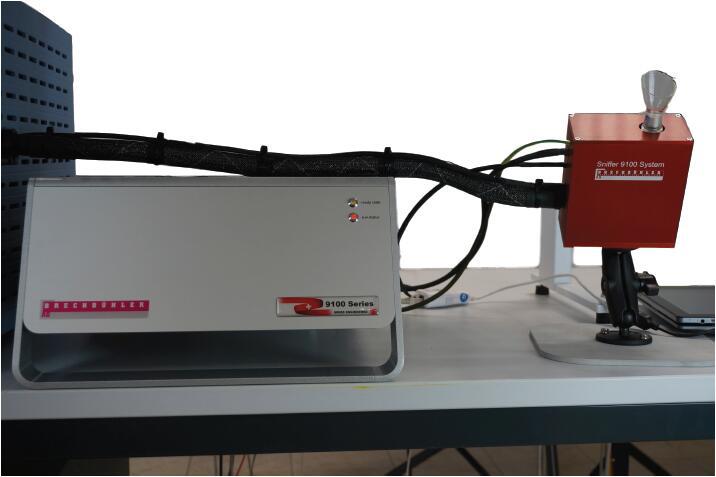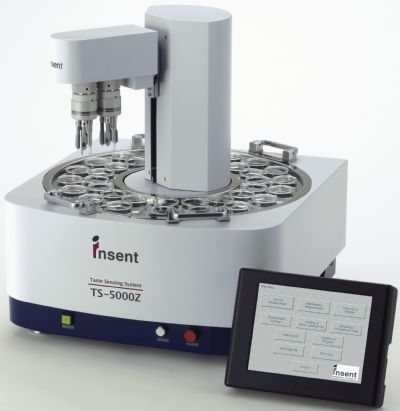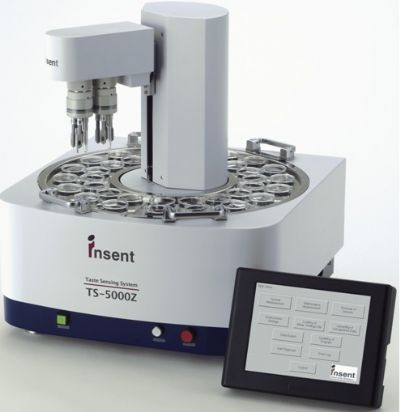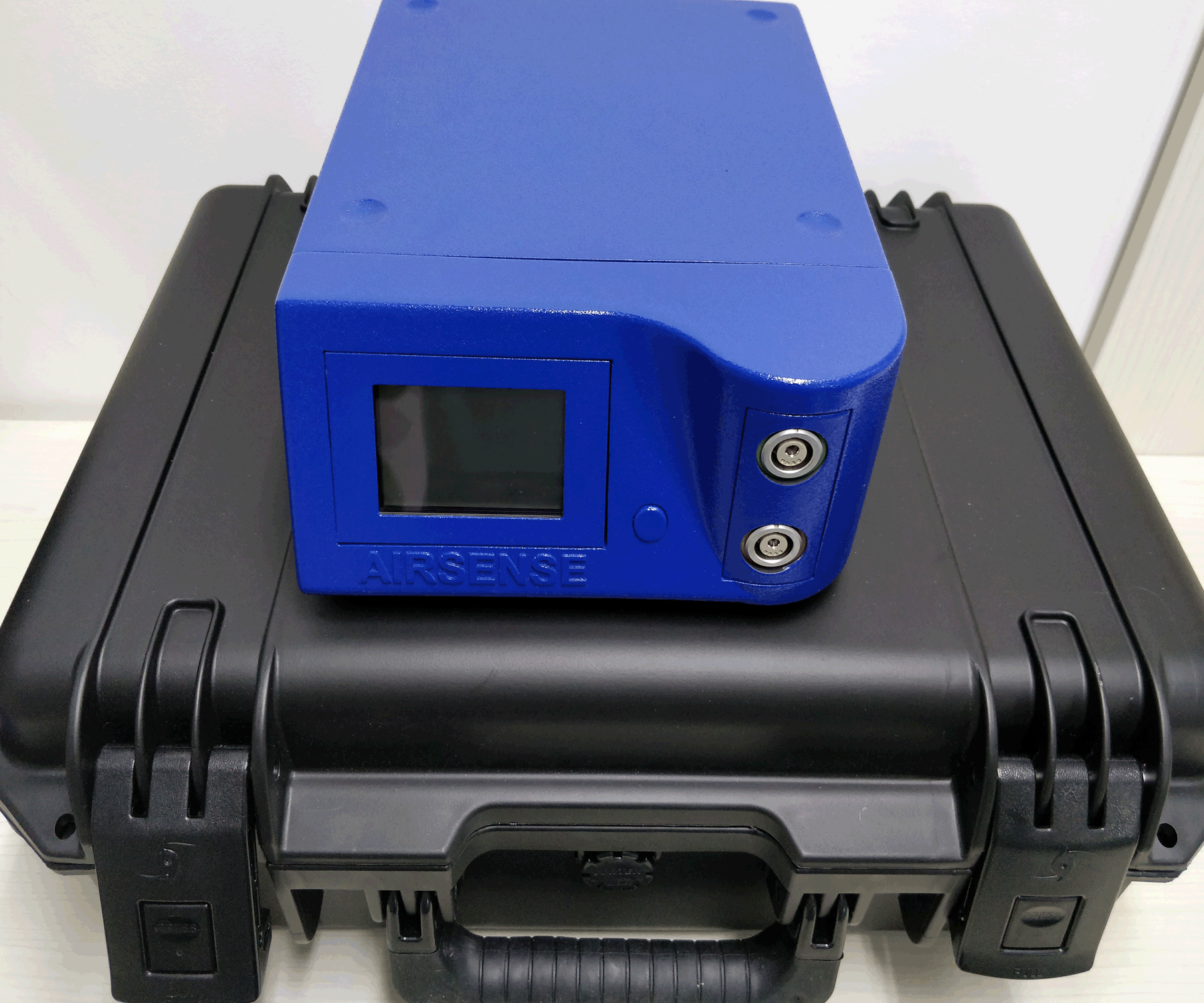
方案详情
文
本研究提出了一种新颖的框架组成的卷积神经网络骨干(CNN骨干)和支持向量机分类器(SVM分类器),也就是说,CNN-SVM毛峰绿茶的分类类别(六子类别)和Maojian绿茶类别使用电子鼻数据(6类)。为CNN主干构造多通道输入矩阵,从不同传感器信号中提取深度特征。
方案详情

2 of 17Foods 2021,10,795 Foods 2021, 10,7953 of 17 Foods 2021,10,795. https://doi.org/10.3390/foods10040795https://www.mdpi.com/journal/foods Citation: Yu, D.; Gu, Y. A MachineLearning Method for theFine-Grained Classification of GreenTea with Geographical IndicationUsing a MOS-Based Electronic Nose.Foods 2021,10, 795. https://doi.org/10.3390/foods10040795 Academic Editors: AlessandraBendini and Yoshio Makino Received: 17 January 2021Accepted: 30 March 2021 Published: 8 April 2021 Publisher's Note: MDPI stays neutralwith regard to jurisdictional claims inpublished maps and institutional affil-iations. Copyright: O 2021 by the authors.Licensee MDPI, Basel, Switzerland.This article is an open access articledistributed under the tconditions of the Creative CommonsAttribution (CC BY) license (https://creativecommons.org/licenses/by/4.0/). Dongbing Yu 1t@Dand Yu Gu 1,2,3,4,*,t 1 College of Information Science and Technology, Beijing University of Chemical Technology,Beijing 100029, China; yudongbing@mail.buct.edu.cn 2 Beijing Advanced Innovation Center for Soft Matter Science and Engineering, Beijing University ofChemical Technology, Beijing 100029, China 3 Guangdong Province Key Laboratory of Petrochemical Equipment Fault Diagnosis, Guangdong University of Petrochemical Technology, Maoming 525000, China 4 Department of Chemistry, Institute of Inorganic and Analytical Chemistry, Goethe-University,Max-von-Laue-Str. 9, 60438 Frankfurt, Germany *Correspondence: guyu@mail.buct.edu.cn十These authors contributed equally to this work. Abstract: Chinese green tea is known for its health-functional properties. There are many green teacategories, which have sub-categories with geographical indications (GTSGI). Several high-qualityGTSGI planted in specific areas are labeled as famous GTSGI (FGTSGI) and are expensive. However,the subtle differences between the categories complicate the fine-grained classification of the GTSGI.This study proposes a novel framework consisting of a convolutional neural network backbone(CNN backbone) and a support vector machine classifier (SVM classifier), namely,CNN-SVM for theclassification of Maofeng green tea categories (six sub-categories) and Maojian green tea categories(six sub-categories) using electronic nose data. A multi-channel input matrix was constructed forthe CNN backbone to extract deep features from different sensor signals. An SVM classifier wasemployed to improve the classification performance due to its high discrimination ability for smallsample sizes. The effectiveness of this framework was verified by comparing it with four othermachine learning models (SVM, CNN-Shi, CNN-SVM-Shi, and CNN). The proposed framework hadthe best performance for classifying the GTSGI and identifying the FGTSGI. The high accuracy andstrong robustness of the CNN-SVM show its potential for the fine-grained classification of multiplehighly similar teas. Keywords: green tea; electronic nose; convolutional neural network; support vector machine 1. Introduction Tea is one of the most popular drinks in the world and is enjoyed by many consumers.According to the reports of the Tea Association of the USA, $2.58 billion were spent inthe specialty tea category in 2019, and green tea accounted for about 15% of the total teaconsumption [1]. People appreciate green tea, a beverage with health-functional properties,for its benefits in preventing and controlling various diseases, such as different kinds ofcancer, heart disease, and liver disease [2]. Green tea is a 'non-fermented' tea and typicallyconsists of one tea bud covered in white hair and one or two leaves [3], with extremelysmall differences in aroma [4]; thus, it is not easy to distinguish green teas by appearance oraroma. The authentic green teas are processed using traditional methods, including fixation,rolling and drying using baking or pan firing [5,6]. China has many green tea categories,including Longjing tea, Biluochun tea, Maofeng tea, and Maojian tea [7]. Each green teacategory has several sub-categories with geographical indications (GTSGI), such as XihuLongjing tea, Suzhou Biluochun tea, Huangshan Maofeng tea, and Xinyang Maojian tea, with significant price differences. Several high-quality GTSGI planted in specific areas arelabeled as famous GTSGI (FGTSGI) and are very popular in China, such as HuangshanMaofeng tea in Anhui province and Xinyang Maojian tea in Henan province; these teas areamong the ten famous teas in China [8,9]. The FGTSGI are typically more expensive thanordinary teas of the same sub-category, and fraudulent labeling of products has become aproblem. Therefore, geographical origin discrimination is important to protect consumers'interests and producers’reputations. Typically, the discrimination of different teas isachieved by chemical detection [10] or sensory evaluation [11]. However, chemistry-basedmethods, such as gas chromatography-olfactometry [12] and gas chromatography-massspectrometry [13], are time-consuming and laborious. Sensory evaluation methods relyheavily on taste experts, and the results may be affected by the individual's physicalcondition or emotional state. Therefore, a rapid and convenient method is urgently neededto distinguish different teas objectively and reliably. An electronic nose (E-nose) is a chemical measurement system that measures thechemical properties of sample gases and consists of a sampling system, a sensor array unit,and a data acquisition and processing system [14]. The sensor array can detect volatilecompounds in the sample gases and provides feature information (sensor responses inthe array). The E-nose has been increasingly used to analyze foods and beverages [15-19].In recent years, many researchers have tried to distinguish tea categories using an E-nosesystem. Liu et al. [20] proposed a fast and effective random forest approach for distinguish-ing teas in six categories (white tea, green tea, black tea, yellow tea,dark tea, and oolongtea) with an E-nose and achieved an accuracy of 100%. Banerjee et al. [21] used an E-noseand a k-nearest neighbor algorithm to classify four black teas from different origins withan accuracy of 86.25%. Lu et al.[22] utilized an E-nose and a random forest approach todistinguish seven Longjing tea samples with different prices obtained from different com-panies and achieved an accuracy of over 95%. Although the E-nose has been successfullyapplied for analyzing teas, most studies primarily focused on distinguishing teas in dif-ferent categories [20,23,24] or teas in the same category from different production areas orwith different qualities [21,22,25]. Few studies focused on the fine-grained classification oftea in different categories (categories) and from different production areas (sub-categories)simultaneously. Green teas typically have light aromas with subtle differences betweendifferent green tea categories or sub-categories. These slight differences coupled withan increasing number of sub-categories have complicated the classification. Therefore,the evaluation of the discriminative characteristics that distinguish different teas is notstraightforward. Many studies focused on improving the performance of the E-nose systemby selecting sensitive material [26], optimizing the sensor array [27], or enhancing the fea-ture extraction methods and algorithms [28,29]. The feature extraction method is a crucialaspect of the optimization methods, and it is important to extract useful information fromthe sensor signals [30] To the best of our knowledge, most researchers employing E-nosesused steady-state or transient-state features (maximum values [31,32], stable values [33,34],integrals [35,36], and derivatives [36,37]). However, using only one feature may miss crucialinformation useful for classification, and manual fusion of multiple features is challengingdue to differences in the sensor types and the detection targets in real applications. A convolutional neural network (CNN) is a feedforward neural network designedto process data in multiple arrays by extracting local and global features [38]. CNNs canautomatically mine the potential information using an appropriate convolution structureand feed the information to a classifier providing good performance. Due to their strongfeature extraction ability and excellent performance, CNNs are widely used for imageprocessing [39], speech recognition [40], and processing matrix data. A CNN is a deeplearning method, and large amounts of data are essential for model training, which mayprove difficult in practical applications. Therefore, selecting a suitable classifier is vital.Due to the limitations of CNNs, few studies used them in E-nose applications. In 2019,Shi et al. [41] employed a CNN model to extract the volatile compound profile of beerusing an E-nose. Ten metal oxide semiconductor (MOS) sensors were used, and the first 90 sample points obtained from each sensor (90 x 10 sample points) were convertedinto a 30 × 30 matrix for input to the CNN. Although the proposed method achieveda classification accuracy of 96.67%, the 30x 30 input matrix (transformed simply from10 sensors' data) was difficult to interpret. The sensor array in an E-nose system has highcross-sensitivity because each sensor in the E-nose is typically not sensitive for only asingle kind of substance, but rather for a certain range of substances, some of which dooverlap [42]. Thus, it is essential to consider the correlation between the sensors to improveclassification accuracy. This paper presents an effective approach for the fine-grained classification of green teawith geographical indication based on a novel deep learning framework using a MOS-basedE-nose. The framework consists of a CNN backbone and a support vector machine (SVM)classifier and is referred to as CNN-SVM. This study makes the following contributions: 1. A preprocessing scheme inspired by the multi-channel input to the CNN model usedin image processing is proposed for the 10-channel E-nose’s data. The channel’ssensor data are converted into a single matrix, and the combined matrices of the10 channels represent the multi-channel data. 2. The network structure of the proposed CNN-SVM, a CNN backbone with a SVM clas-sifier, is analyzed. In the framework,the deep CNN is designed to mine the volatilecompound information of the tea samples (automatically), and the SVM is used toclassify the data (small sample sizes) to improve the classification performance. 3. A comprehensive study on the fine-grained classification of green tea with geographi-cal indication is presented, demonstrating the high accuracy and strong robustness ofthe proposed CNN-SVM framework. 2. Materials and Methods 2.1. General Information of Tea Samples Twelve green teas (six Maofeng teas and six Maojian teas) from different geographicalorigins were used in this study, including Huangshan Maofeng (HSMF), Yandang Maofeng(YDMF), Emei Maofeng (EMMF), Lanxi Maofeng (LXMF), Qishan Maofeng (QSMF), MeitanMaofeng (MTMF), Xinyang Maojian (XYMJ), Guilin Maojian (GLMJ), Duyun Maojian. /-(DYMJ), Guzhang Maojian (GZMJ), Queshe Maojian (QSMJ), and Ziyang Maojian (ZYMJ).The details of the producing areas are presented in Table 1. The 12 green teas came fromeight provinces (Anhui,Zhejiang, Sichuan, Guizhou, Henan, Guangxi, Hunan, and Shaanxi)in China; the geographical information is shown in Figure 1. Figure 1. Geographical information of the tea-producing areas. (a) Location of the eight provinces (Anhui, Zhejiang, Sichuan,Guizhou, Henan, Guangxi,Hunan, and Shaanxi) in China; (b) Huangshan City and Chizhou City in Anhui Province;(c)Wenzhou City and Jinghua City in Zhejiang Province; (d) Yaan City in Sichuan Province; (e) Zunyi City and QiannanPrefecture in Guizhou Province; (f) Xinyang City in Henan Province; (g) Guilin City in Guangxi Province;(h) Changde Cityin Hunan Province; (i) Ankang City in Shaanxi Province. Among these green teas, HSMF tea and XYMJ tea are the two most important productswith a protected designation of origin in China. HSMF tea is a famous Maofeng green tea produced in Huangshan City, Anhui Province (29°42 33.26"N, 118°19'02.37" E); theprotection zone of the HSMF tea is shown in Figure 2a [43]. The tea is primarily grownnear Huangshan Mountain at altitudes of over 700 m [8]. The annual rainfall in this areais 1500-1800 mm, the average annual temperature is 15.5-16.4℃, and the cumulativesunshine hours are 1674-1876 h. The humid, cloudy conditions are an ideal growingenvironment for high-quality tea. XYMJ tea is a well-known local product in XinyangCity, Henan Province (32°07'23.79"N, 114°04’30.11" E). The protection zone of the XYMJtea is shown in Figure 2b [44]. The tea plantations are located on the western part of thenorth slope of Dabie Mountain and the eastern part of the north slope of Tongbai Moun-tain. The average altitude is 500-800 m. The annual rainfall in this area is 900-1400 mm,the average annual temperature is 15.1-15.3℃, and the cumulative sunshine hours are1900-2100 h. XYMJ tea grown in this area has a light fragrance and has a sweet, heavy,and mellow taste [45]. Figure 2. Protection zones for products of geographical indication. (a) HSMF tea in Huangshan City,Anhui Province; (b) XYMJ tea in Xinyang City, Henan Province. 2.2. Experimental Samples and Conditions In this study, all the tea samples (twelve teas with special-class levels) were purchasedfrom specialty stores approved by the China Tea Marketing Association. The tea waspicked and processed 14 days before the Pure Brightness Festival (around April 5 or 6)in 2019 and is called "before-brightness tea". The details of the tea samples are listedin Table 1. Photos of the 12 green teas are shown in Figure 3. Table 1. Details of the 12 tea samples. No. Maofeng Tea Maojian Tea Name Producing Area Price ($/50 g) Name Producing Area Price ($/50 g) 1 HSMF Huangshan City, Anhui Province 47.2 XYMJ Xinyang City, 42.1 Henan Province Guilin City, Guangxi Province 2 YDMF Wenzhou City, Zhejiang Province 39.4 GLMJ 17.7 3 EMMF Yaan City, Sichuan Province 15.5 DYMJ Qiannan Prefecture, 39.8 Guizhou Province Changde City, 4 LXMF Jinghua City, Zhejiang Province Chizhou City, Anhui Province 26.0 GZMJ 35.5 Hunan Province Zunyi City, 5 QSMF 22.6 QSMJ 16.8 Guizhou Province 6 MTMF Zunyi City, Guizhou Province 13.1 ZYMJ Ankang City, Shaanxi Province 27.3 Figure 3. Photos of the 12 green teas. (a)HSMF;(b) YDMF; (c) EMMF; (d) LXMF;(e)QSMF; (f) MTMF; (g)XYMJ; (h)GLMJ; (i) DYMJ; (j) GZMJ; (k)QSMJ;(1) ZYMJ. A commercial E-nose (PEN3, Airsense Analytics GmbH, Germany; the details of thePEN3 can be found on the company's website [46]), with 10 MOS sensors was used toacquire volatile compound profile of the tea samples. The details of the MOS sensors areshown in Table 2 [47]. Table 2. Details of the 10 sensors in the PEN3. No. Sensor Main Performance 1 W1C Sensitive to aromatic compounds 2 W5S High sensitivity to nitrogen oxides, broad range sensitivity 3 W3C Sensitive to ammonia and aromatic compounds 4 W6S Sensitive mainly to hydrogen 5 W5C Sensitive to alkanes and aromatic components and less sensitive to polar compounds 6 W1S Sensitive to methane, broad range sensitivity 7 W1W Sensitive primarily to sulfur compounds and many terpenes and organic sulfur compounds 8 W2S Sensitive to ethanol and less sensitive to aromatic compounds 9 W2W Sensitive to aromatic compounds and organic sulfur compounds 10 W3S Highly sensitive to alkanes The experiments were conducted for 12 days in a clean testing room of the authors’laboratory (with good ventilation and an area of about 45 square meters) at a temperatureof 25 ℃ ±1°℃ and a humidity level of 40% ±2%. The 12 green teas (six Maofeng teasand six Maojian teas) were measured 10 times per day by a professional and experiencedoperator, and the tea samples for daily experiments were updated. The acquisition of thevolatile compound profile was conducted in a well-ventilated location to minimize baselinefluctuations and interference from other volatile compounds. The zero gas (a baseline) wasproduced using two active charcoal filters (Filter 1 and Filter 2 in Figure 4) to ensure thatthe reference air and the air used for the samples had the same source. The workflow of the E-nose includes the collection stage and flushing stage. As isshown in Figure 4, for each tea, a 4 g tea sample was placed into a 50 mL sampler for 180 sto allow the tea's volatile compounds to disperse into the sampler. Before the measurement,clean air was pumped through filter 2 into the E-nose with a flow rate of 10 mL/s inthe direction of In 2 for 100 s. The automatic adjustment and calibration of the zero gasis called zero-point trim; the values relative to the zero-point values were recorded as abaseline.After the calibration, the tea sample’s volatile gas in the sampler was pumpedinto the E-nose with a flow rate of 10 mL/s in the direction of In 1 to contact the sensorarray for 100 s. The gas molecules were adsorbed on the sensors' surface, changing thesensors'conductivity due to the redox reaction on the surface of the sensor’s active element.The sensors' conductivity eventually stabilized at a constant value when the adsorption was saturated. The collection stage lasted 100 s, and sampling continued at one sampleper second. Figure 5 shows examples of the 10 sensors’response curves in the collectionstage for the 12 tea samples. The response value R of the sensor was calculated with theequation R= Go/G, where Go is the conductivity of the sensor in reference air (in thecalibration stage), and G is the conductivity of the sensor exposed to the sample vapor(in the data collection stage). The sensor chamber was flushed with the zero gas betweenmeasurements. In this step, the clean air was pumped into the E-nose with a flow rateof 10 mL/s in the direction of In 2 for 100 s. The zero gas flushed the sensor surface tocompletely remove the analytes. The flushing and data collection stages were repeated toobtain the raw data of 12 tea samples. Therefore, the dataset contained 1440 measurements(12 tea samples x 10 measuring times × 12 days). Figure 4. Schematic diagram of the PEN-3 workflow. Figure 5. Examples of the 10 sensors’ response curves. (a) HSMF; (b) YDMF; (c) EMMF; (d) LXMF; (e)QSMF; (f) MTMF;(g) XYMJ; (h) GLMJ; (i) DYMJ; (j) GZMJ; (k) QSMJ; (1)ZYMJ. 2.3. Principal Component Analysis (PCA) A PCA is a multivariate statistical technique used to reduce the dimensionality ofraw complex data and extract meaningful information [48]. With minimal effort, PCA canbe used to construct a set of new orthogonal variables called principal components usingorthogonal linear transformation [49]. The first few principal components often have largevariances and explain most of the sample variance. Usually, the first few components,whose cumulative variance exceeds 95% are selected as the principal components [50].Thus, the PCA is an effective data compression method. Similar data points tend to beclustered and unrelated data points are scattered in the PCA projection plot. 2.4. Convolutional Neural Network (CNN) A CNN is a feedforward neural network designed to process data in multiple arraysby extracting local and global features [38]. In image processing, the CNN input is typicallya color image consisting of three 2D arrays containing pixel information in three channels.Due to the flexibility of the data modalities, a CNN can be used in many fields, suchas natural language processing, remote sensing, and sensory data analysis. A typicalarchitecture of a CNN consists of an input layer, a hidden layer, and an output layer.The hidden layer of a CNN is composed of a convolution layer, a pooling layer, and afully-connected layer. The convolution layer and pooling layer are stacked; the formerdetects local features, and the latter merges semantically similar features into one to obtainthe high-level features of the input data. The fully-connected layer is used as a classifier.Each node is connected with all the upper layer nodes to map the feature informationto the decision space [41]. The CNN provides high classification accuracy due to itsunique structure. 2.5. ResNeXt ResNeXt is a novel, simple, and highly modularized network based on the CNN andis designed to improve the image classification accuracy due to its homogeneous, multi-branched architecture [51]. Unlike existing CNN-based networks, such as VGGnet [52] andResNet [53], the ResNeXt model has the cardinality dimension in addition to width anddepth. Cardinality is defined as the size of the set of transformations that are aggregatedto construct a network with the same topology. The addition of cardinality proved to bemore effective than increasing the depth and width, especially when the latter leads todiminishing returns. Thus, the ResNeXt can achieve high accuracy with low complexityfor visual (and non-visual) recognition tasks. 2.6. Support Vector Machine (SVM) An SVM is a supervised learning and classification algorithm based on statisticaltheory [54]. An SVM can map input data that is not linearly separable in a low-dimensionalspace to a high-dimensional space non-linearly using a kernel function.A hyperplane isconstructed in the high-dimensional space to maximize the margin between two classes andclassify the data in the high-dimensional space. The most commonly used kernel functionis the radial basis function (RBF), which has resulted in high classification performance [55].Since SVM performs structural risk minimization, it is regarded as a good classifier fornonlinear data and small sample sizes. 2.7. Model Eualuation Metrics Model evaluation metrics are used to assess the algorithm performance in supervisedlearning. Common metrics include accuracy, recall, precision, F1 score, and Kappa score.As shown in Figure 6, a confusion matrix that provides the True Positive (TP), FalsePositive (FP), True Negative (TN),and False Negative (FN) parameters is used to calculatethe metrics. True condition Totalpopulation Condition positive Condition negative Predictedcondition Predictedconditionpositive True positive,Power False positive,Type|error Predictedconditionnegative False negative,Type|| error True negative Figure6. Calculation of the performance metrices by confusion matrix. Accuracy represents the proportion of samples that are correctly classified (includingTP samples and TN); it is defined as follows: Recall(R) is defined as the ratio of the TP samples to the sum of the TP and FNsamples. Precision(P) is defined as the ratio of the TP samples to the sum of the TP andFP samples. The equations of recall and precision are: The F1 score considers the recall and precision and is calculated as follows: The Kappa score is a statistic that measures the agreement between categories and isused to evaluate the classification accuracy; it is calculated as: where po represents the total classification accuracy, and pe represents the expected agreements. 3. Proposed Method A CNN with an appropriate structure can mine the deep features of the input dataand has a flexible form. However, more data are required for CNN model training than fora traditional statistical model [41], and the data volume may not be sufficient for practicalE-nose applications, potentially resulting in overfitting. The SVM is considered a goodclassifier for small sample sizes, but it is difficult to select or extract valid features using theSVM. In this study, we combined the advantages of these two algorithms and proposed theCNN-SVM framework. The deep CNN structure was used to mine the volatile compoundinformation of the tea from the raw data of the E-nose, and the SVM was used to classifythe data to achieve high classification accuracy. The proposed CNN-SVM frameworkconsisting of a CNN backbone and an SVM classifier is shown in Figure 7. Figure 7. Schematic diagram of the CNN-SVM structure. 3.1. Data Preprocessing The 10-channel sensor array in the PEN3 system has high cross-sensitivity becauseeach sensor is sensitive to a certain range of substances, and there is some overlap. The E-nose data need to be preprocessed before determining the correlation between the sensorsfor the input of the CNN model. Therefore, data preprocessing is crucial to improve theclassification accuracy. Inspired by the multi-channel input to the CNN model used inimage processing, the raw data of the 10 sensors were converted into a 10-channel inputfor the CNN. As is shown in Figure 7, the matrix form of the original data was 100 ×10,where 100 represents the number of sampling times in the data collection stage (100 s) foreach sensor, and 10 represents the number of sensors. The 100 raw data points obtainedfrom each sensor were converted into a 10× 10 matrix, and the 10 matrices of the sensorswere concatenated into a 10 × 10 ×10 matrix as a 10-channel input of the CNN backbone. 3.2. Proposed CNN-SVM Framework Inspired by ResNeXt, a CNN backbone was designed to extract the deep features fromthe 10-channel input data. As shown in Figure 8, the CNN backbone consisted of fourstages, including Conv 1, Layer 1, Layer 2, and Pool 1. The Conv 1 stage had a kernel sizeof1 x1and a stride of 1 to expand the number of input channels when a large number offeature maps were constructed with features from different channels.The Layer 1 stageand Layer 2 stage, which consisted of m ResBlocks and n ResBlocks, respectively, wereused to reduce the size of the feature maps when a large number of deep features wereobtained (m =3 and n=3 in this study). As shown in Figure 9, the input feature maps wereprocessed in the ResBlock by several grouped convolutional layers (the first 1×1 layer,the 3×3layer, and the second 1×1 layer). The number of grouped convolutional layerswas defined as cardinality (c) and was set to 4 in this study. In each grouped convolution,the first 1 ×1 layer had a kernel size of1 ×1 and a stride of 1 to adjust the number of inputchannel (in_ch) to bottleneck width (bw). The 3×3 layer in the grouped convolutionallayers hada 3×3 convolution kernels with a stride of s, whose input and output channelswere both bw-dimensional (bw=4 in this study) to obtain the valid features of the featuremaps. The number of output channels (out_ch) was adjusted by the second 1 ×1 layerwith a kernel of 1×1 and a stride of 1, and the outputs of the grouped convolutional layerswere concatenated along with the output of the input by a skip connection as the outputof the ResBlock. The skip connection retained features in different layers in the forwardpropagation that allowed the model to reuse these features and accelerate the trainingspeed. In this study, the in_ch was 16, the s was 1, and the out_ch was 32 in Layer 1 foreach ReBlock, respectively. Thus, the sizes of the input feature maps remained the samewhen more deep features were obtained. In Layer 2, the in_ch was 32, and the out_ch was64 for each ResBlock. The s of the first ResBlock was 2, and the s of the two other ResBlockswas 1 to reduce the sizes of the feature maps when local features were obtained. Sixty-fourfeatures were obtained by the global average layer, and the feature map of each channelwas integrated into one feature. The details of the CNN backbone are listed in Table 3. CNN backbone Figure 8. Schematic diagram of the CNN backbone. Figure 9. Schematic diagram of the ResBlock . Table 3. Details of the CNN backbone Stage Output Structure Details Conv 1 10 ×10×16 1 ×1, 16,stride=1 1×1,16 LayerI 10×10×32 3×3, 16 ×3 1×1,32 1×1,32 Layer 2 5×5×64 3×3,32 x3 1×1,64 Pool 1 1×1×64 .global average pool The 64 features obtained by the CNN backbone were first fed to the CNN classifierconsisting of two fully-connected layers for the training of the CNN backbone. The firstfully-connected layer was activated by a ReLU function with 32 neurons, and the secondfully-connected layer was activated by a Sigmoid function with 12 neurons to increase thenonlinear expression ability of the model. A weighted cross-entropy loss function was usedand was minimized by the stochastic gradient descent (SGD) optimizer with a learningrate of a (a=0.001 in this study). A warm-up strategy was used in the initialization ofthe learning rate for a smooth training start, and a reduction factor of b (b= 0.0001 in thisstudy) was used to reduce the learning rate after every training epoch. The batch size was 12, and the CNN framework (CNN backbone + CNN classifier)was trained for d (d=500 in this study) epochs. When the model had converged on the training set, the model parameters of the CNN backbone were saved. Subsequently,the CNN classifier was replaced by the SVM classifier in the CNN backbone to construct theCNN-SVM model. The RBF was chosen as the kernel function, and a grid search methodwas used to search the other two important parameters (penalty factor and gamma) toobtain the best performance of the SVM model. Ten-fold cross-validation was used fortraining the SVM model; the training set was the same as the one used for CNN training.The proposed CNN-SVM algorithm is summarized in Algorithm 1. Algorithm 1CNN-SVM Input: training data. Output: predicted category. Begin Step1: train the CNN backbone with the CNN classifier on the training data Step2: save the parameters of the CNN backbone Step3: replace the CNN classifier with the SVM classifier Step4: test the CNN-SVM model on the test data Step5: output the classification results End 4. Results and Discussion 4.1. Principal Component Analysis PCA is an unsupervised method commonly used for pattern recognition. PCA canintuitively show the data distribution in a low-dimensional space by extracting meaningfulinformation from the raw data. Since the conventional method uses a stable value as thestatic characteristic, the data obtained from each sensor from 81-100 s from 120 randomlychosen tea samples (12 tea samples × 10 measuring times x1 day) was used as an exampleto present the PCA result. The projections of the two first primary components of thePCA computed for the tea samples is shown in Figure 10. The x-axis represents principalcomponent 1 (PC 1) with 70.92% variance, and the y-axis represents principal component2 (PC 2) with 24.51% variance. The cumulative variance of PC 1 and PC 2 was 95.43%,showing a small loss of information. The PCA method allows data to be grouped accordingto the similarity of the input characteristics to determine the distance between classesas shown in Figure 10. If the clusters are well separated, high classification accuracyis expected. If the clusters are in close proximity or overlap, low accuracy is expected.As shown in Figure 10, the PCA results show a relatively high overlap between the classes,indicating that this method is not suitable for separating the classes. Figure 10. Projection of the first two principal components of the PCA of the tea samples. 4.2. Comparison of the Classification Results of five Models In this study, the classification performances of the SVM and CNN used in the CNN-SVM were compared with that of the proposed CNN-SVM model using multiple evalu-ation metrics (accuracy recall, precision, F1 score, and Kappa score). The models were implemented using two NVIDIA GTX 1080TI graphics cards and the open-source Py-Torch framework. As a conventional method that uses the static characteristics of the gas sensor signals,the SVM model was first used to distinguish the 12 teas from different areas. Similar to thePCA approach, the last 20 data points (81-100 s) of the 10 sensors were used as input tothe SVM model. A dataset of 1080 measurements obtained in the first nine days (12 teasamples x 10 measuring times x9 days) was used for training and was expressed as a21,600 ×10 matrix. A dataset of 360 measurements obtained in the last three days (12 teasamples x 10 measuring times ×3 days) was used for testing and was expressed as a7200 ×10 matrix. The RBF was chosen as the kernel function of the SVM model. A gridsearch method was used to search the two important parameters with the best performanceusing 10-fold cross-validation on the training set. The parameters included the penaltyfactor [1, 10, 50, 100, 200, 500] and the gamma [0.01, 0.1, 1, 5, 10,20]. A training accuracyof 100% was obtained. Thus, the penalty factor and the gamma were set to 100 and 1,respectively. The classification results of the SVM model on the test set are shown in Table 4.Five evaluation metrics, including accuracy, recall, precision, F1 score, and Kappa score,were computed for a comprehensive and accurate assessment of the classification model.The SVM achieved an accuracy of 72.5%, a recall of 72.5%, a precision of 86.24%, an F1 scoreof 75.24%, and a Kappa score of 70%, respectively. The SVM model provided unsatisfactoryperformance, and the experimental results showed that it lacked generalization ability anddid not mine a sufficient number of features useful for the fine-grained classification of 12green teas from different geographical origins using only the stable values. The proposed CNN framework consisting of the CNN backbone and the CNN classi-fier was given the 10-channel input and trained using the CNN backbone. The dataset of1080 measurements in the first nine days (12 tea samples x10 measuring times ×9 days)was used for training and was expressed as a 1080 x 10× 10 matrix. The dataset of360 measurements in the last three days (12 tea samples x10 measuring times ×3 days)was used for testing and was expressed as a 360 ×10×10 matrix. For training the CNNmodel, 10-fold cross-validation was used to verify the model performance on the trainingset. The loss and cross-validation curves of the CNN model during the training processare shown in Figure 11. The CNN model converged after 480 epochs. We saved the modelparameters and tested the CNN model on the test set. As shown in Table 4, the CNNmodel achieved relatively good performance with an accuracy of 91.39%, a recall of 91.39%,a precision of 93.75%, an F1 score of 91.52%, and a Kappa score of 90.61%. The experi-mental results showed that the deep features extracted from the 10-channel input, whichconsidered the correlation between the sensors, provided better performance than the SVMmodel for the fine-grained classification of the 12 green teas. Table 4. Results of five evaluation metrics for classifications by five models. Model Accuracy Recall Precision F1 Score Kappa Score SVM 0.7250 0.7250 0.8624 0.7524 0.7000 CNN-Shi [41] 0.8527 0.8527 0.8683 0.8516 0.8939 CNN-SVM-Shi [41] 0.9111 0.9111 0.9142 0.9104 0.9030 The proposed CNN 0.9139 0.9139 0.9375 0.9152 0.9061 The proposed CNN-SVM 0.9611 0.9611 0.9686 0.9603 0.9576 Figure 11. Loss and cross-validation curves of the CNN model during the training process. The proposed CNN-SVM framework consisting of the CNN backbone and the SVMclassifier was provided with the 10-channel input. The training set and test set werethe same as those used for the CNN framework. The CNN backbone in the CNN-SVMframework used the model parameters of the trained CNN framework at 480 epochs.A grid search method was used to search the penalty factor [1, 10,50,100,200,500] andthe gamma [0.01, 0.1, 1, 5, 10, 20] with the best performance using 10-fold cross-validationon the training set. The penalty factor was set to 1, and gamma was set to 0.1; a trainingaccuracy of 100% was achieved on the training set. As shown in Table 4, the CNN-SVMmodel achieved the best performance on the test set, with an accuracy of 96.11%, a recallof 96.11%, a precision of 96.86%, an F1 score of 96.03%, and a Kappa score of 95.76%.The experimental results indicated that the SVM classifier significantly improved theclassification performance due to its good discrimination ability for small sample sizes.The effectiveness of the combination of the CNN and SVM was demonstrated for theclassification of tea using an E-nose system in a practical application. Furthermore, the CNN model proposed by Shi et al. [41] (CNN-Shi) was also testedfor comparison with the proposed method. For consistency, in the CNN-Shi model, the first90 sampling points for each sensor (90×10 totally) were converted into a 30 ×30 matrixfor the CNN. The CNN-Shi framework consisted of 4 convolutional layers,3 pooling layers,and 2 fully-connection layers. After the convolutional and pooling operations, 128 featureswere obtained to as input to the fully-connected layers to obtain the classification results.The training set and test set were consistent with those used in the proposed CNN frame-work. The CNN-Shi model was also trained for 500 epochs and achieved an accuracy of85.27%, a recall of 85.27%, a precision of 86.83%, an F1 score of 85.16%, and a Kappa scoreof 89.39%, as shown in Table 4. In addition, we also replaced the fully-connected layers ofthe CNN-Shi model with an SVM to establish the CNN-SVM-Shi model for comparisonwith the proposed CNN-SVM model. The model parameters of the CNN-Shi model weresaved at 480 epochs, and a grid search method was also used to search the best parametersfor the SVM. The results are shown in Table 4. The model had an accuracy of 91.39%,a recall of 91.39%, a precision of 93.75%, an F1 score of 91.52%, and a Kappa score of 90.61%.The performances of the proposed CNN model and CNN-SVM model are better thanthose of the CNN-Shi model and CNN-SVM-Shi model,respectively. The experimentalresults further demonstrated the effectiveness of the 10-channel input of the CNN modeldue to the cross-sensitivity of the sensors. The results indicate that the proposed methodprovided better performances for mining deep features from the sensor signals and conducta fine-grained classification using the E-nose system. An experiment was performed (distinguishing the two FGTSGI from the 12 GTSGI)to demonstrate the practical applicability of the CNN-SVM framework. The F1-scores of the classes are listed in Table 5. The proposed CNN-SVM model outperformed theother four models for the identification of the two most famous and expensive teas withprotected designation of origin (F1 scores of 97.77% for HSMF and 99.31% for XYMJ).The experimental results indicated that the model could accurately distinguish HSMF andXYMJ from the other Maofeng and Maojian tea sub-categories. Table 5. Results of F1 scores for classifications by five models. Class SVM CNN-Shi [41] CNN-SVM-Shi[41] The Proposed CNN TheProposed CNN-SVM HSMF 0.8302 0.9310 0.9474 0.9474 0.9777 YDMF 0.5000 0.8462 0.9667 0.9355 0.9731 EMMF 0.8000 0.9375 0.9677 1.0000 1.0000 LXMF 0.8000 1.0000 1.0000 1.0000 1.0000 QSMF 0.8000 0.6441 0.7234 0.6957 0.8924 MTMF 0.8000 0.8333 0.8364 0.8519 0.9108 XYMJ 0.7532 0.8150 0.9166 0.9474 0.9931 GLMJ 0.8000 0.7937 0.8824 0.8696 0.9375 DYMJ 0.8000 0.9231 1.0000 1.0000 1.0000 GZMJ 0.8000 0.8824 0.8955 0.9016 0.9438 QSMJ 0.5455 0.6129 0.7887 0.8333 0.8955 ZYMJ 0.8000 1.0000 1.0000 1.0000 1.0000 5. Conclusions In this study, a CNN-SVM framework was proposed for the fine-grained classificationof green tea with geographical indication using a MOS-based E-nose. The experimentswere conducted on 12 green tea samples (six Maofeng green teas and six Maojian greenteas). The main conclusions of this study are as follows: 1. PCA, an unsupervised method, was used to show the separability of the 12 teasample data (stable values) obtained from the E-nose. Not surprisingly, the PCAresults showed that this method was ineffective for classifying the sample due torelatively high overlap. The stable values combined with an SVM model were usedto distinguish the teas; this approach had poor performance. It showed that the staticcharacteristics were not sufficient for the fine-grained classification of the 12 greenteas, and meaningful feature information was lost. 2. A 10-channel input matrix, which was obtained by converting the raw data of the10-channel MOS-based sensors (each sensor for one channel) in the E-nose system,was constructed to mine the deep features using the CNN model. The multi-channeldesign considered the cross-sensitivity of the sensors and contained sufficient detailsfor the classification tasks, providing a novel feature extraction method for E-nosesignals in practical applications. 3. A CNN-SVM framework consisting of the CNN backbone and the SVM classifier wasproposed to perform the classification using the 10-channel input matrix. The novelstructure of the CNN backbone based on ResNeXt was effective for extracting thedeep features from the different channels automatically. The SVM classifier improvedthe generalization ability of the CNN model and increased the classification accuracyfrom 91.39% (CNN backbone + CNN classifier) to 96.11% (CNN backbone+SVMclassifier) among the 12 green teas due to its good discrimination ability for smallsample sizes. 4. Compared with the other four machine learning models (SVM, CNN-Shi,CNN-SVM-Shi, and CNN), the proposed CNN-SVM provided the highest scores of the fiveevaluation metrics for the classification of the GTSGI: accuracy of 96.11%, recall of96.11%, precision of 96.86%, F1 score of 96.03%, and Kappa score of 95.76%. Excellentperformance was obtained for identifying the FGTSGI, with the highest F1 scoresof 97.77% (for HSMF) and 99.31% (for XYMJ). These experimental results demon- strated the effectiveness of the CNN-SVM for the classification of the GTSGI and theidentification of the FGTSGI. In conclusion, the combined strategy of CNN and SVM enhanced the detection per-formance of multiple highly similar green teas. The proposed method provided highclassification accuracy, showing that the tea quality differed for different geographical indi-cations. Moreover, the method is rapid, convenient, and effective for classifying green teas.In the future, the potential of this method will be explored for other teas (or other foods) toexpand the application of the proposed framework combined with the E-nose. We expectthat the framework has a promising potential for using machine learning methods forfood authentication. Author Contributions: Conceptualization, D.Y. and Y.G.; methodology, D.Y. and Y.G.; validation,D.Y. and Y.G.; formal analysis, D.Y.; Writing-original draft preparation, D.Y.; writing-review andediting, Y.G.; visualization, Y.G.; supervision, Y.G.; funding acquisition, Y.G. All authors have readand agreed to the published version of the manuscript. Funding: This research was funded by the Ministry of Science and Technology of the People'sRepublic of China [Grant No. 2017YFB1400100] and the National Natural Science Foundation ofChina [Grant No.61876059]. Institutional Review Board Statement: Not applicable. Informed Consent Statement: Not applicable. Data Availability Statement: The data presented in this study are available at Figshare (https://doi.org/10.6084/m9.figshare.14375927.v1 (accessed on 16 January 2021)). Conflicts of Interest: The authors declare no conflict of interest. Abbreviations The following abbreviations are used in this manuscript: GTSGI Green Tea with Geographical Indication FGTSGI Famous Green Tea with Geographical Indication CNN Convolutional Neural Network SVM Support Vector Machine CNN-SVM a CNN backbone combined with a SVM classifier CNN-Shi a CNN model proposed by Shi et al.[41] CNN-SVM-Shi CNN-Shi combined with a SVM classifier E-nose Electronic Nose MOS Metal Oxide Semiconductor HSMF Huangshan Maofeng YDMF Yandang Maofeng EMMF Emei Maofeng LXMF Lanxi Maofeng QSMF Qishan Maofeng MTMF Meitan Maofeng XYMT Xinyang Maojian GLMJ Guilin Maojian DYMJ Duyun Maojian GZMT Guzhang Maojian QSMJ Queshe Maojian ZYMT Ziyang Maojian PCA Principal Component Analysis RBF Radial Basis Function True Positive False Positive TN True Negative FN False Negative RRecall P PrecisionSGD Stochastic Gradient DescentPC1 Principal Component 1 PC2 Principal Component 2 References 1. The State of the U.S. Tea Industry 2019-20. Available online: Http://en.ctma.com.cn/index.php/2019/12/09/green-tea-market-expected-to-grow (accessed on 15 November 2020). 3. Wang, X.;Huang, J;Fan, W.; Lu, H. Identification of green tea varieties and fast quantification of total polyphenols by near-infrared spectroscopy and ultraviolet-visible spectroscopy with chemometric algorithms. Anal. Methods 2015,7,787-792. 4Graham, H.N. Green tea composition, consumption, and polyphenol chemistry. Prev. Med. 1992,21,334-350. [PubMed] 5 Huang, D.; Qiu, Q.; Wang, Y.; Wang, Y.; Lu,Y.; Fan, D.; Wang, X. Rapid Identification of Different Grades of Huangshan MaofengTea Using Ultraviolet Spectrum and Color Difference. Molecules 2020, 25,4665. 6. Ye, N.; Zhang, L.; Gu, X. Classification of Maojian teas from different geographical origins by micellar electrokinetic chromatogra-phy and pattern recognition techniques. Anal. Sci.2011, 27,765. 7. Hu, L.; Yin, C. Development of a new three-dimensional fluorescence spectroscopy method coupling with multilinear patternrecognition to discriminate the variety and grade of green tea. Food Anal. Methods 2017,10,2281-2292. 8. Zeng, X.; Tian, J.; Cai, K.; Wu, X.; Wang, Y.;Zheng, Y.;Cui, L. Promoting osteoblast differentiation by the flavanes from HuangshanMaofeng tea is linked to a reduction of oxidative stress. Phytomedicine 2014, 21, 217-224. 9Guo, G.Y.; Hu, K.F.; Yuan, D. The chemical components of xinyang maojian tea. Food Sci. Technol. 2006,9,298-301. Lv, H.P.; Zhong, Q.S.; Lin, Z.; Wang, L.; Tan, J.F.;Guo, L. Aroma characterisation of Pu-erh tea using headspace-solid phasemicroextraction combined with GC/MS and GC-olfactometry. Food Chem. 2012,130,1074-1081. 11. Zhu, H.; Ye, Y.; He, H.; Dong, C. Evaluation of green tea sensory quality via process characteristics and image information.Food Bioprod. Process. 2017, 102,116-122. 12. Sasaki, T.; Koshi, E.; Take, H.; Michihata, T.; Maruya, M.; Enomoto, T. Characterisation of odorants in roasted stem tea using gas chromatography-mass spectrometry and gas chromatography-olfactometry analysis. Food Chem.2017,220,177-183.13. Tan, H.R.; Lau, H.; Liu, S.Q.; Tan, L.P.; Sakumoto,S.; Lassabliere,B.; Yu, B. Characterisation of key odourants in Japanese green tea using gas chromatography-olfactometry and gas chromatography-mass spectrometry. LWT 2019,108,221-232.Boeker, P. Onelectronic nose'methodology. Sens. Actuators B Chem. 2014, 204, 2-17. Wei, H.;Gu, Y. A Machine Learning Method for the Detection of Brown Core in the Chinese Pear Variety Huangguan Using aMOS-Based E-Nose. Sensors 2020, 20, 4499.[CrossRef] 18. Russo, M.; Serra, D.; Suraci, F.;Di Sanzo,R.; Fuda, S.; Postorino,S. The potential of e-nose aroma profiling for identifying thegeographical origin of licorice (Glycyrrhiza glabra L.) roots. Food Chem. 2014,165,467-474. 19..Russo, M.; di Sanzo,R.; Cefaly, V.;Carabetta,S.; Serra, D.; Fuda,S. Non-destructive flavour evaluation of red onion (Allium cepa L.)Ecotypes: An electronic-nose-based approach. Food Chem. 2013, 141, 896-899. 20. Liu, H.; Li, Q.;Gu, Y. Convenient and accurate method for the identification of Chinese teas by an electronic nose. IEEE Access2019,11,79-88. 21. Banerjee, M.B.;Roy, R.B.; Tudu, B.; Bandyopadhyay, R.; Bhattacharyya, N. Black tea classification employing feature fusion ofE-Nose and E-Tongue responses. J. Food Eng. 2019,244,55-63. 22. Lu, X.; Wang, J; Lu, G.; Lin, B.; Chang, M.;He, W. Quality level identification of West Lake Longjing green tea using electronicnose. Sens. Actuators B Chem. 2019,301,127056. 23. Gao, T.; Wang, Y.; Zhang, C.; Pittman,Z.A.;Oliveira, A.M.; Fu, K.; Willis, B.G. Classification of tea aromas using multi-nanoparticlebased chemiresistor arrays. Sensors 2019, 19,2574. 24. Ruengdech, A.; Siripatrawan, U. Visualization of mulberry tea quality using an electronic sensor array, SPME-GC/MS, andsensory evaluation. Food Biosci. 2020, 36, 100593. 25. Wang, X.; Gu,Y.; Liu, H. A transfer learning method for the protection of geographical indication in China using an electronicnose for the identification of Xihu Longjing tea. IEEE Sens. J. 2021, 21,8065-8077.[CrossRef] 26. Le Maout, P.; Wojkiewicz, J.L.; Redon, N.; Lahuec, C.; Seguin, F.; Dupont, L.; Pud, A. Polyaniline nanocomposites-basedsensor array for breath ammonia analysis. Portable e-nose approach to non-invasive diagnosis of chronic kidney disease.Sens. Actuators B Chem. 2018,274,616-626. 27. Estakhroyeh, H.R.;Rashedi, E.;Mehran, M. Design and construction of electronic nose for multi-purpose applications by sensorarray arrangement using IBGSA. J. Intell.Robot. Syst. 2018,92,205-221. ( 28. Zhang, S.; X ie, C .; Hu, M . ; L i , H . ; B a i, Z . ; Z e ng, D. An entire fea t ure ext r action met h od of metal oxide gas se n sors. Sens.Actuators B Chem. 2008,132,81-89. [ C rossRef f ] ) ( 29. Liu, H.; Li, Q.; Li, Z.; Gu, Y. A Suppression Method of Concentration Background Noise by Transductive Transfe r Learning for aMetal Oxide Semiconductor-Based Electronic Nose. Sensors 2020, 20,1913. ) ( 31. Wei, Z.; Wang, J .; Zhang, W. Detecting internal quality of peanuts during storage using electronic nose responses combined withphysicochemical methods. Food Chem. 2 015,177,89-96.[ C r o s sRef] ) ( 32. Setkus, A.; Olekas, A.; Senuliene, D.;Falasconi, M.; Pardo, M.; Sberveglieri, G. Analysis of the dynamic features of metal oxidesensors in response t o SPME fiber gas release. S e ns. A c tuators B Chem. 20 1 0, 146, 539-544. ) 33. Llobet, E.; Brezmes, J.; Vilanova,X.; Sueiras,J.E.;Correig,X. Qualitative and quantitative analysis of volatile organic compoundsusing transient and steady-state responses of a thick-film tin oxide gas sensor array. Sens. Actuators B Chem. 1997,41,13-21. 34. Yang, Y.; Liu, H.; Gu, Y. A Model Transfer Learning Framework with Back-Propagation Neural Network for Wine and ChineseLiquor Detection by Electronic Nose. IEEE Access 2020, 8, 105278-105285. [CrossRef] 35.).Zhang, S.; Xie, C.; Zeng, D.;Zhang, Q.; Li, H.; Bi, Z. A feature extraction method and a sampling system for fast recognition offlammable liquids with a portable E-nose. Sens. Actuators B Chem.2007, 124, 437-443. [CrossRef] 36. Distante, C.; Leo, M.; Siciliano, P.; Persaud, K.C. On the study of feature extraction methods for an electronic nose.Sens. Actuators B Chem. 2002,87,274-288. 37. Roussel, S.; Forsberg, G.; Steinmetz, V.; Grenier, P.; Bellon-Maurel, V. Optimisation of electronic nose measurements. Part I:Methodology of output feature selection. J. Food Eng. 1998, 37, 207-222. ( Lecun Y.; Bengio Y .; Hinton G. Deep learning. Nature 2015, 5 21, 436. ) Liang, S.; Liu, H.; Gu, Y.; Guo, X.; Li, H.; Li, L.; Tao, L. Fast automated detection of COVID-19 from medical images usingconvolutional neural networks. Commun. Biol. 2020,4,1-13. 40. Kwon,S. A CNN-assisted enhanced audio signal processing for speech emotion recognition. Sensors 2020, 20, 183. 41. Shi, Y.; Gong, F.; Wang, M.; Liu, J.; Wu, Y.; Men, H. A deep feature mining method of electronic nose sensor data for identifyingbeer olfactory information. J. Food Eng. 2019,263,437-445. 42. Haddi, Z.;Mabrouk, S.; Bougrini, M.; Tahri, K.; Sghaier, K.; Barhoumi, H.; Bouchikhi, B. E-Nose and e-Tongue combination forimproved recognition of fruit juice samples. Food Chem. 2014, 150,246-253.[PubMed] 43. GB/T 19460-2008 Product of Geographical Indication-Huangshan Maofeng Tea. Available online: Http://openstd.samr.gov.cn/bzgk/gb/newGbInfo?hcno=74D2547878A48B143A55D6C3722B6DA7 (accessed on 15 November 2020). 44.CGB/T 22737-2008 Product of Geographical Indication-Xinyang Maojian Tea. Tea Industry 2019-2020. Available online: Http://openstd.samr.gov.cn/bzgk/gb/newGbInfo?hcno=3776C98AEFD24228A55810EDDEBA073B (accessed on 15 November 2020). 45. Cheng, S.;Hu, J; Fox, D.; Zhang, Y. Tea tourism development in Xinyang, China: Stakeholders’ view. Tour. Manag. Perspect. 2012,2,28-34. 46. AIRSENSE Analytics. Available online: Https://airsense.com/en (accessed on 19 March 2021). 47. Shi, Y.; Yuan, H.; Xiong, C.; Zhang,Q.; Jia, S.; Liu, J; Men, H. Improving performance: A collaborative strategy for the multi-datafusion of electronic nose and hyperspectral to track the quality difference of rice. Sens. Actuators B Chem.2021, 333,129546. Abdi, H.; Williams, L.J. Principal component analysis. Wiley Interdiscip. Rev. Comput. Stat. 2012,2, 433-459. Shlens,J.A tutorial on principal component analysis. arXiv 2014, arXiv:1404.1100. Liu, H.; Li,Q.; Yan, B.; Zhang, L.; Gu, Y. Bionic electronic nose based on MOS sensors array and machine learning algorithmsused for wine properties detection. Sensors 2019, 19, 45. [CrossRef] 51. Xie, S.; Girshick, R.; Dollar, P.; Tu, Z.; He, K. Aggregated residual transformations for deep neural networks. In Proceedings of theIEEE Conference on Computer Vision and Pattern Recognition (CVPR), Honolulu, HI, USA, 21-26 July 2017;pp. 1492-1500. 52...Simonyan, K.; Zisserman, A. Very deep convolutional networks for large-scale image recognition. arXiv 2014, arXiv:1409.1556. 53. He, K.; Zhang, X.; Ren, S.; Sun, J. Deep residual learning for image recognition. In Proceedings of the IEEE Conference onComputer Vision and Pattern Recognition (CVPR), Las Vegas,NV, USA, 26 June-1 July 2016; pp.770-778. ( Li, Y.; Zhang,J; L i,T.; Liu, H.; Li,J; Wang, Y. Geographical traceability of wild Boletus edulis based on data fusion of FT-MIRand I CP-AES coupled with data mining methods (SVM). Spectrochim. Acta Part A 20 1 7, 177, 20-27. ) Reproduced with permission of copyright owner. Further reproductionprohibited without permission. 摘要:中国绿茶以其保健功能而闻名。绿茶有很多类别,这些类别都有带有地理标志的子类别(GTSGI)。在特定地区种植的一些高质量GTSGI被标记为著名GTSGI (FGTSGI),价格昂贵。然而,类别之间的细微差别使GTSGI的细粒度分类变得复杂。本研究提出了一种新颖的框架组成的卷积神经网络骨干(CNN骨干)和支持向量机分类器(SVM分类器),也就是说,CNN-SVM毛峰绿茶的分类类别(六子类别)和Maojian绿茶类别使用电子鼻数据(6类)。为CNN主干构造多通道输入矩阵,从不同传感器信号中提取深度特征。由于支持向量机分类器对小样本具有较高的识别能力,因此采用支持向量机分类器来提高分类性能。通过与其他四种机器学习模型(SVM、CNN- shi、CNN-SVM- shi和CNN)的比较,验证了该框架的有效性。该框架在GTSGI分类和FGTSGI识别方面表现最佳。CNN-SVM的高精度和强鲁棒性显示了其在多种高度相似茶叶的细粒度分类方面的潜力。关键词:绿茶;电子鼻子;卷积神经网络;支持向量机
确定
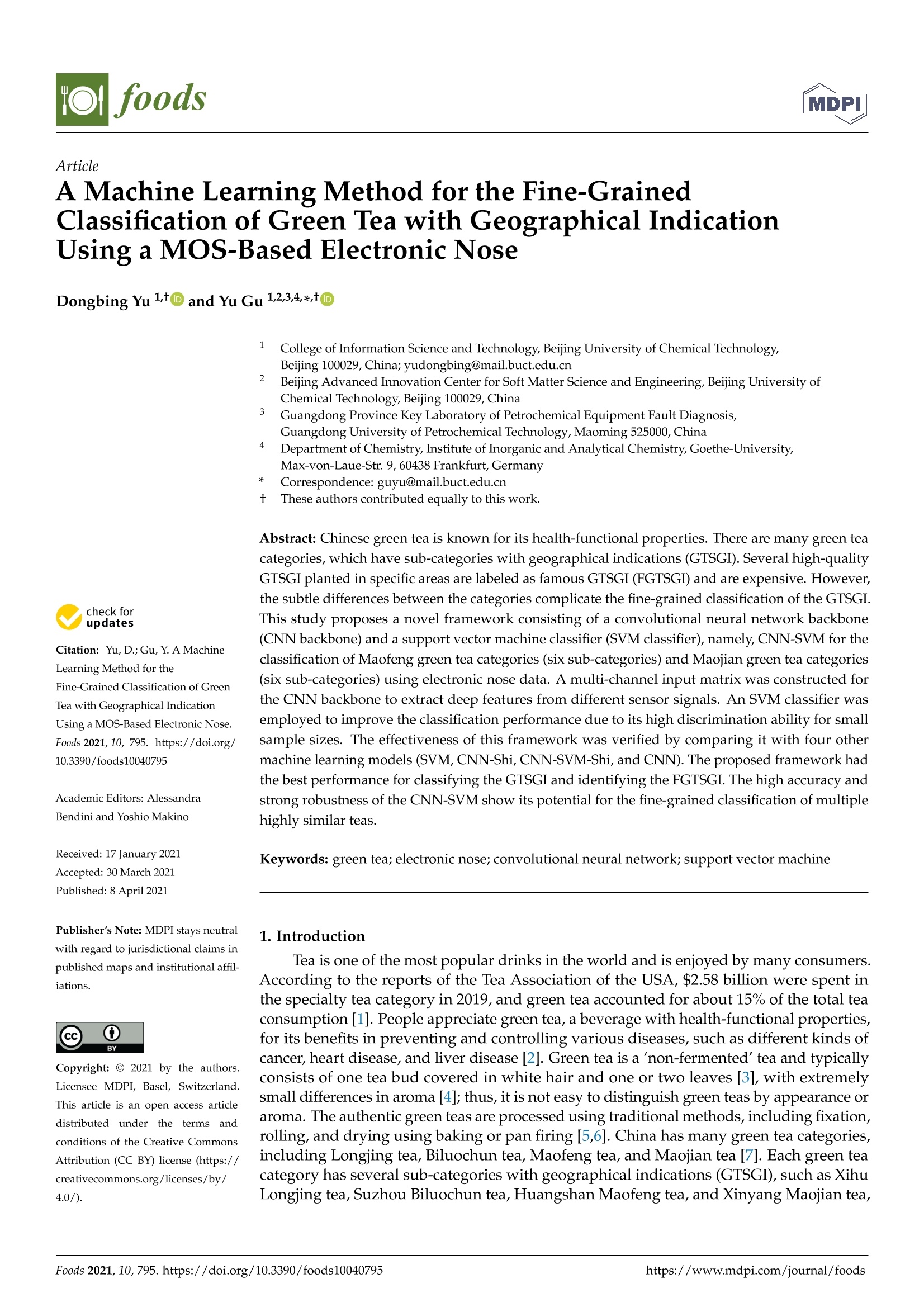
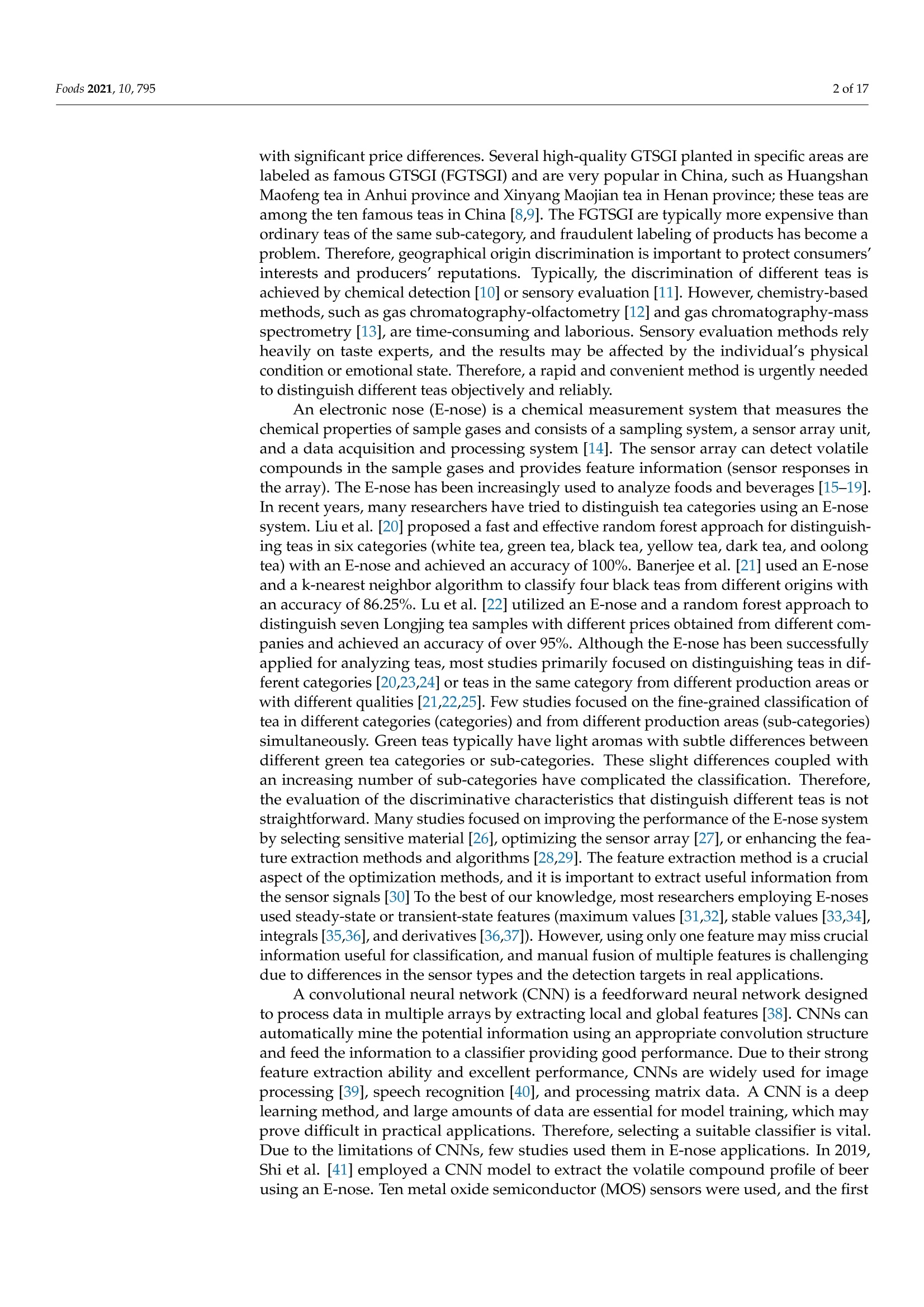
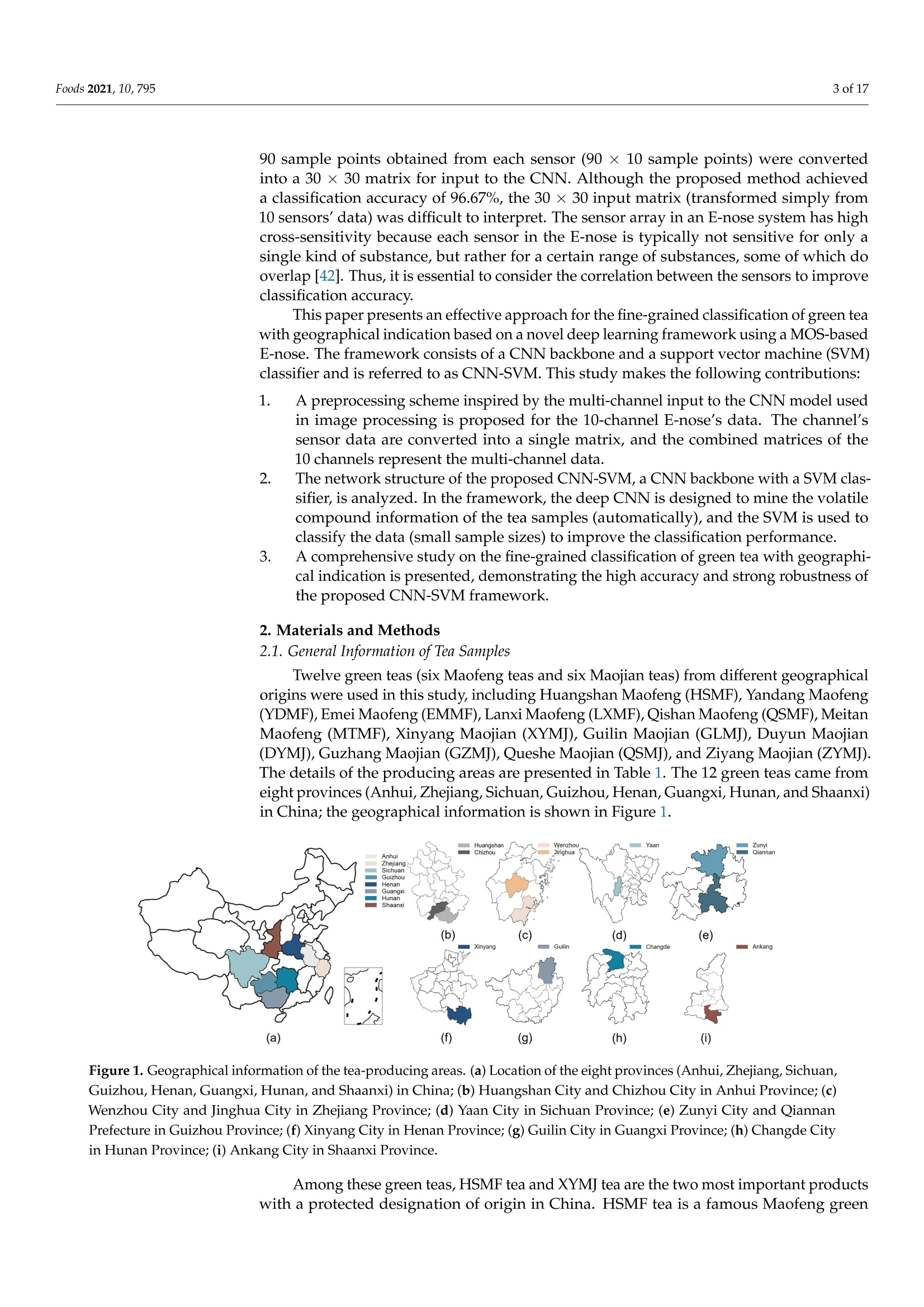
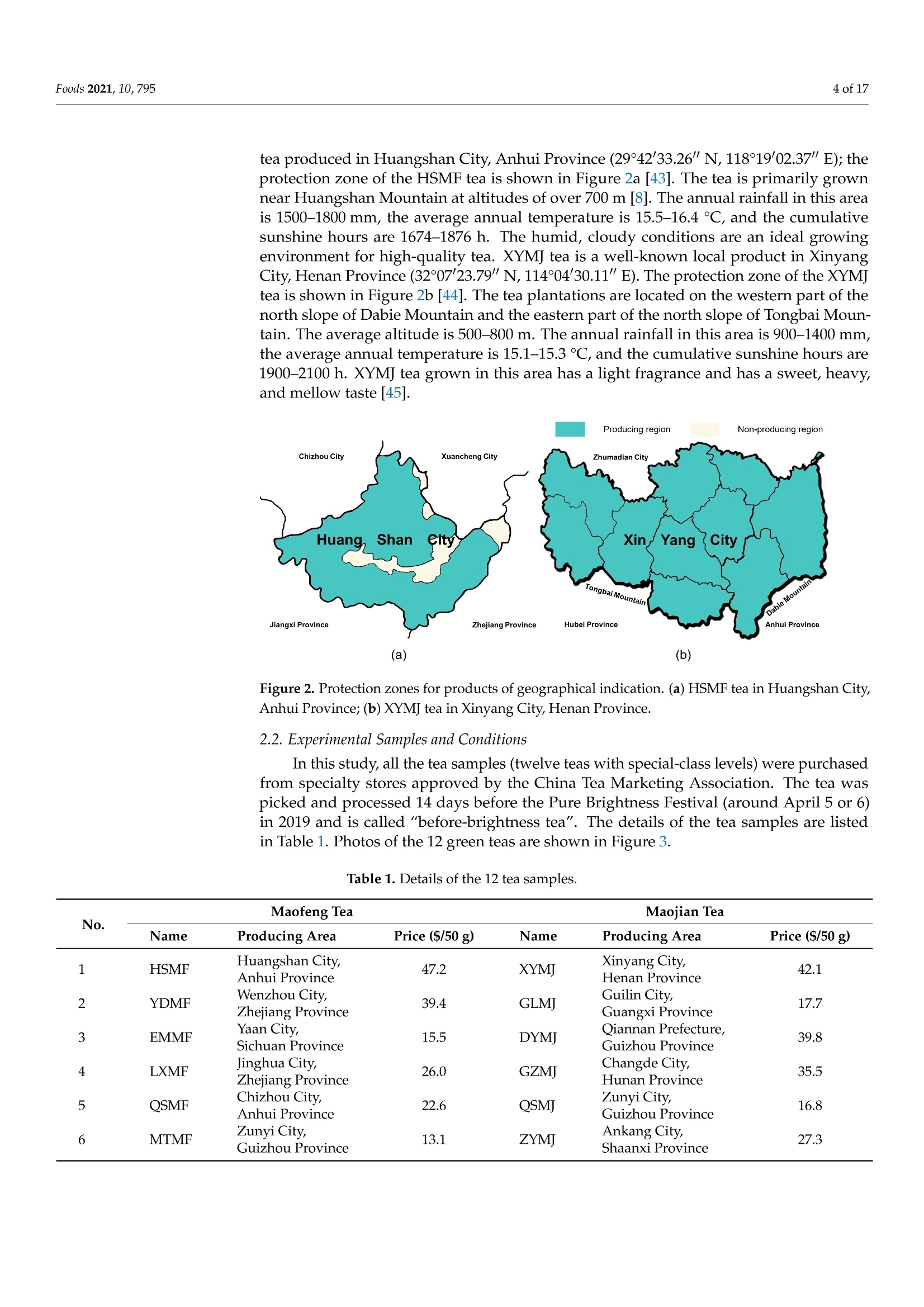
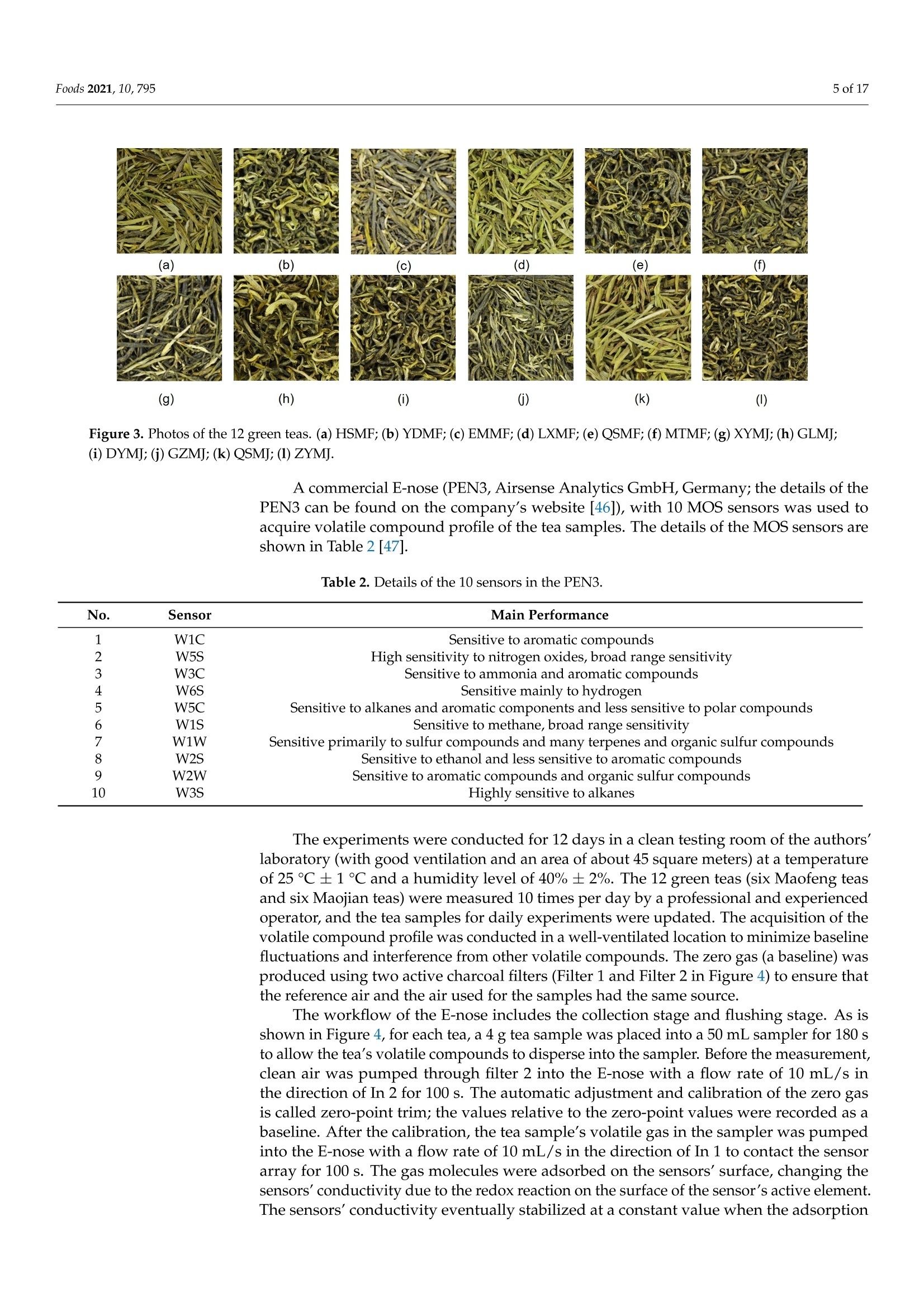
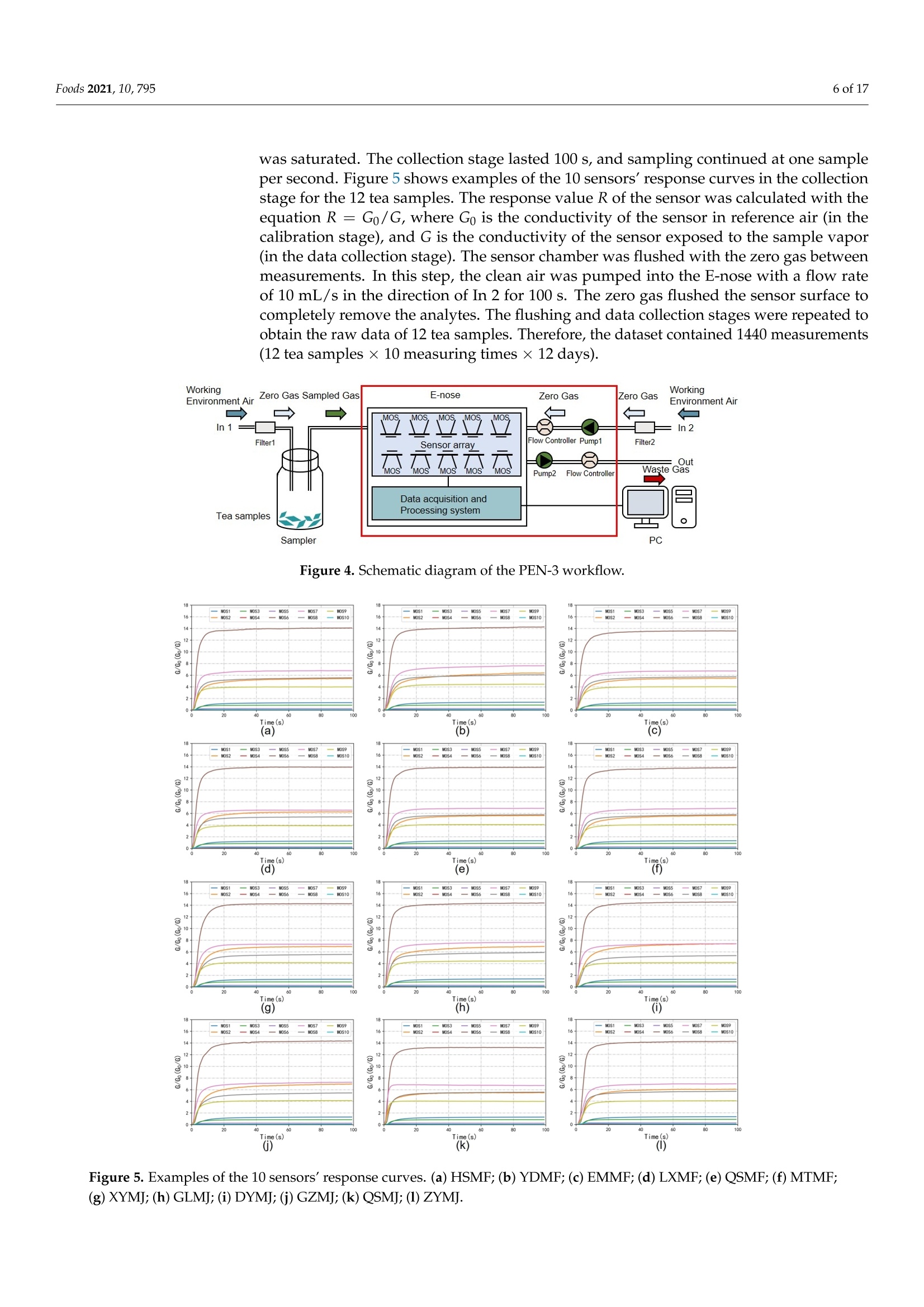
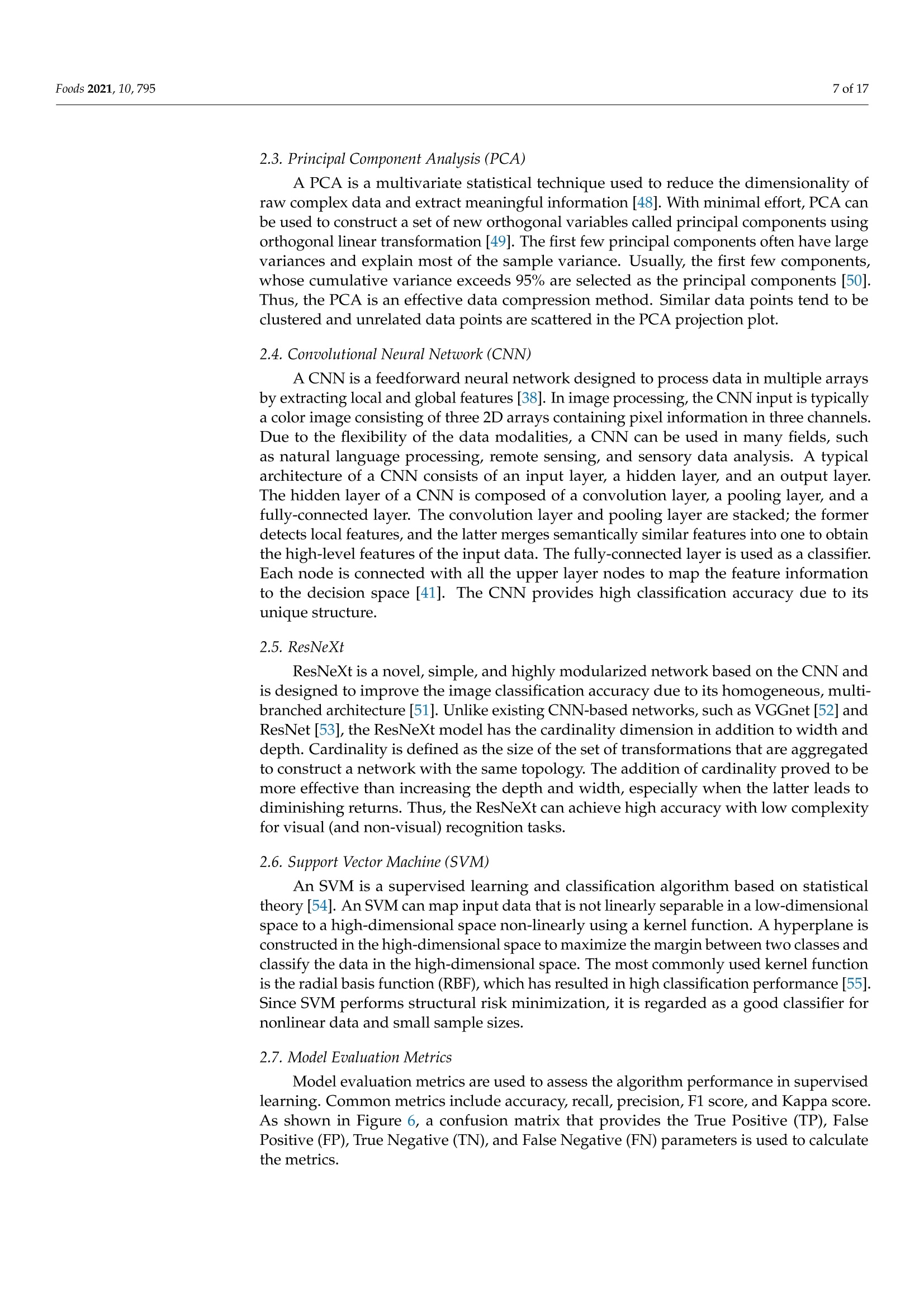
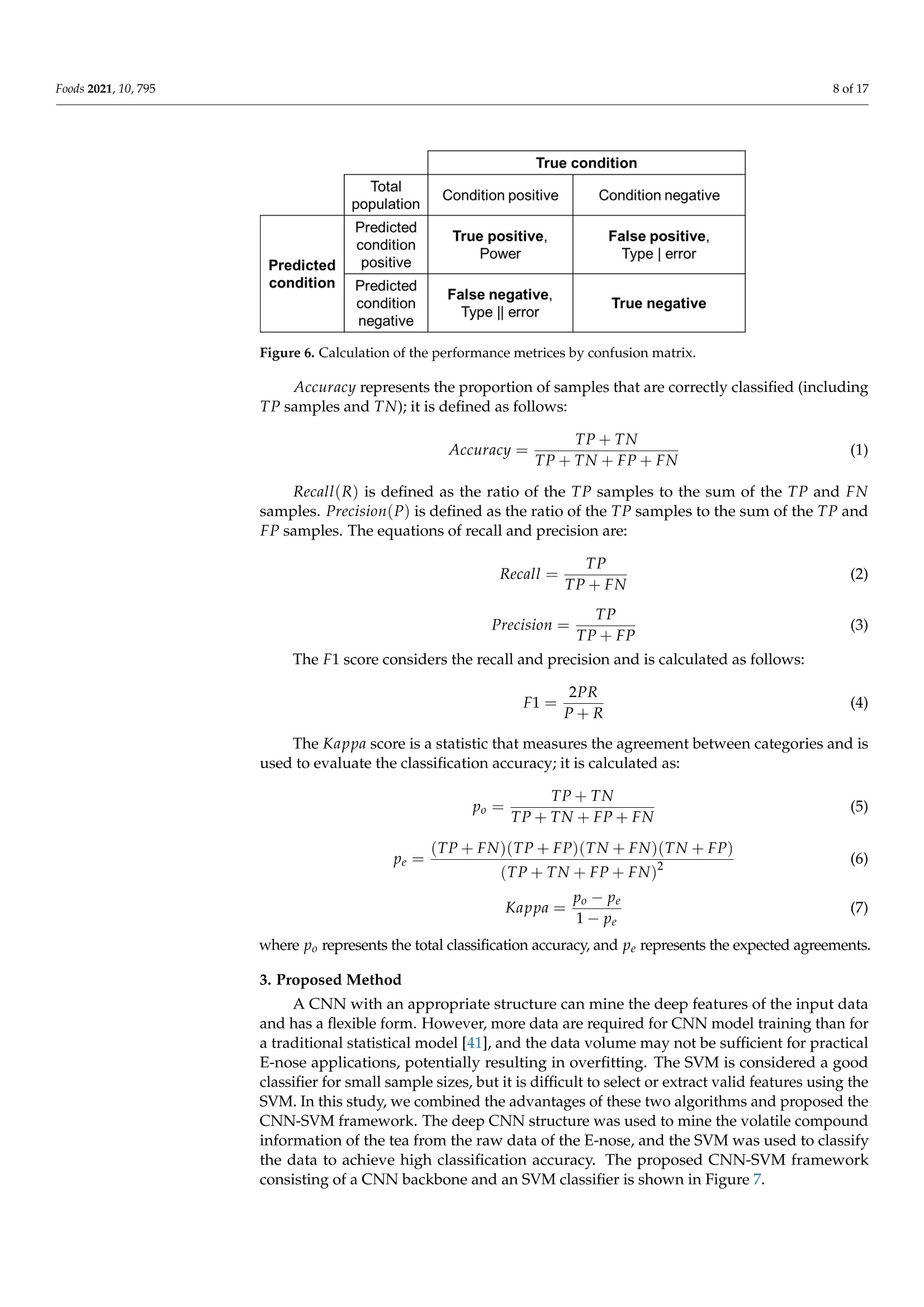


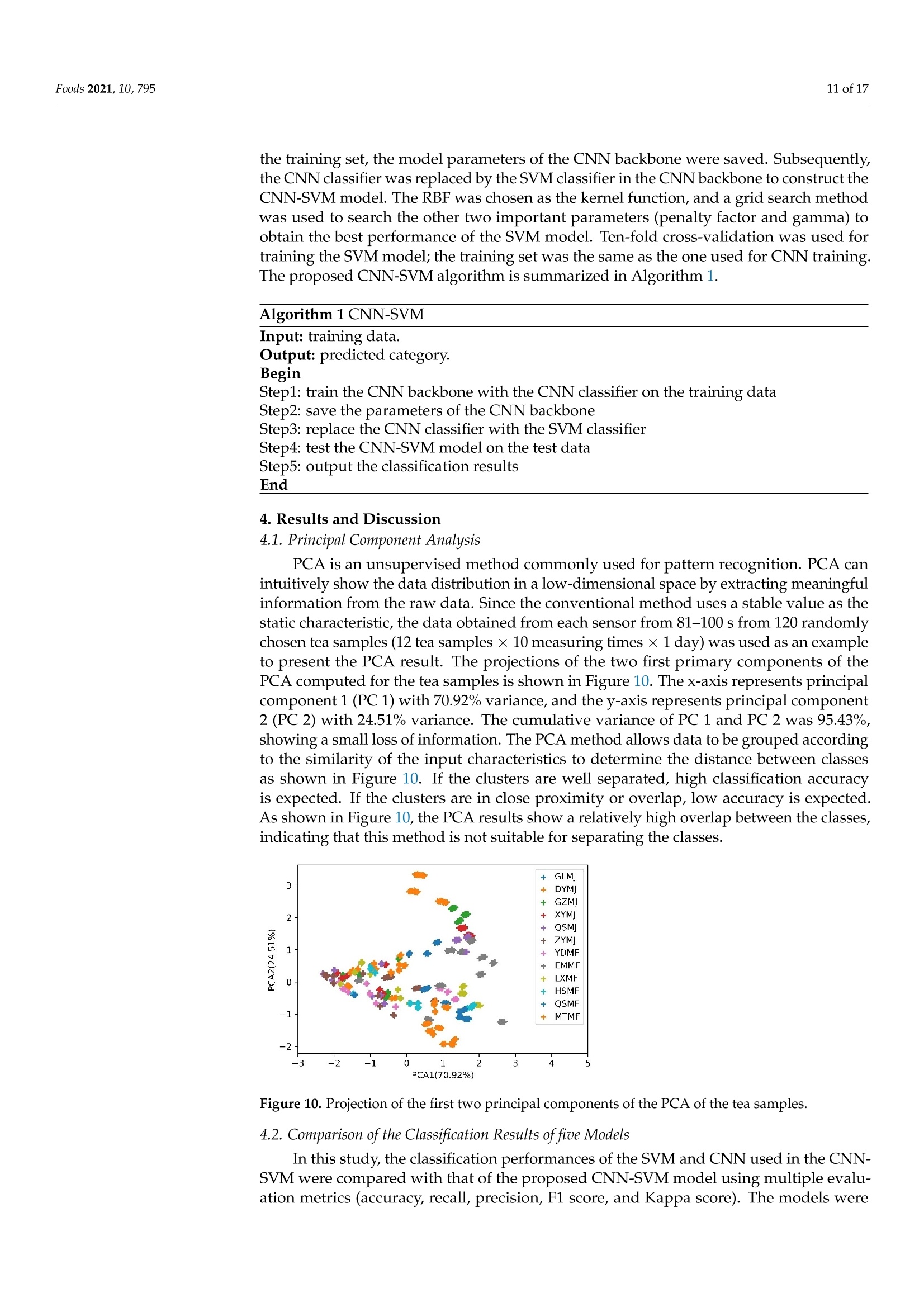
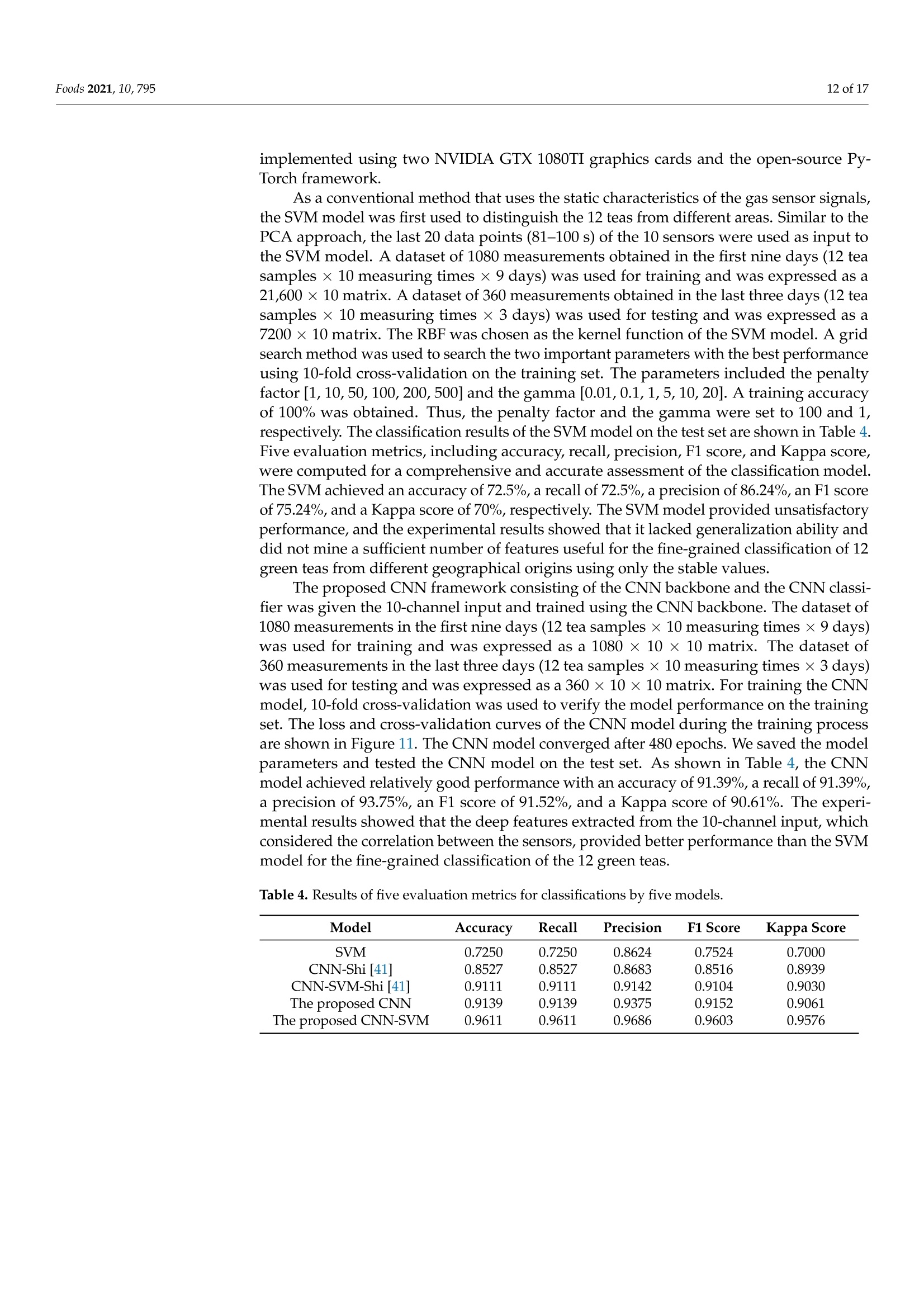
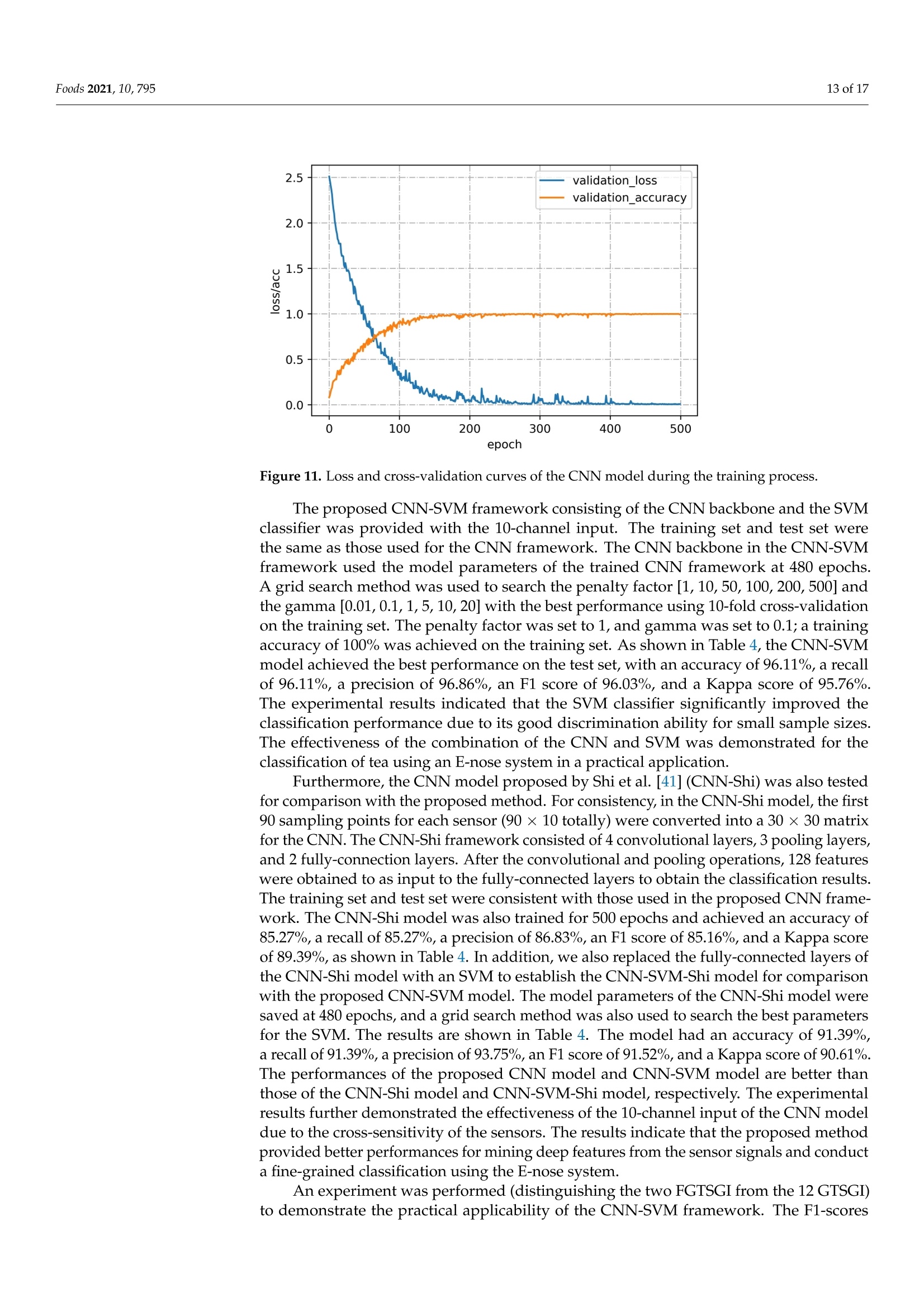
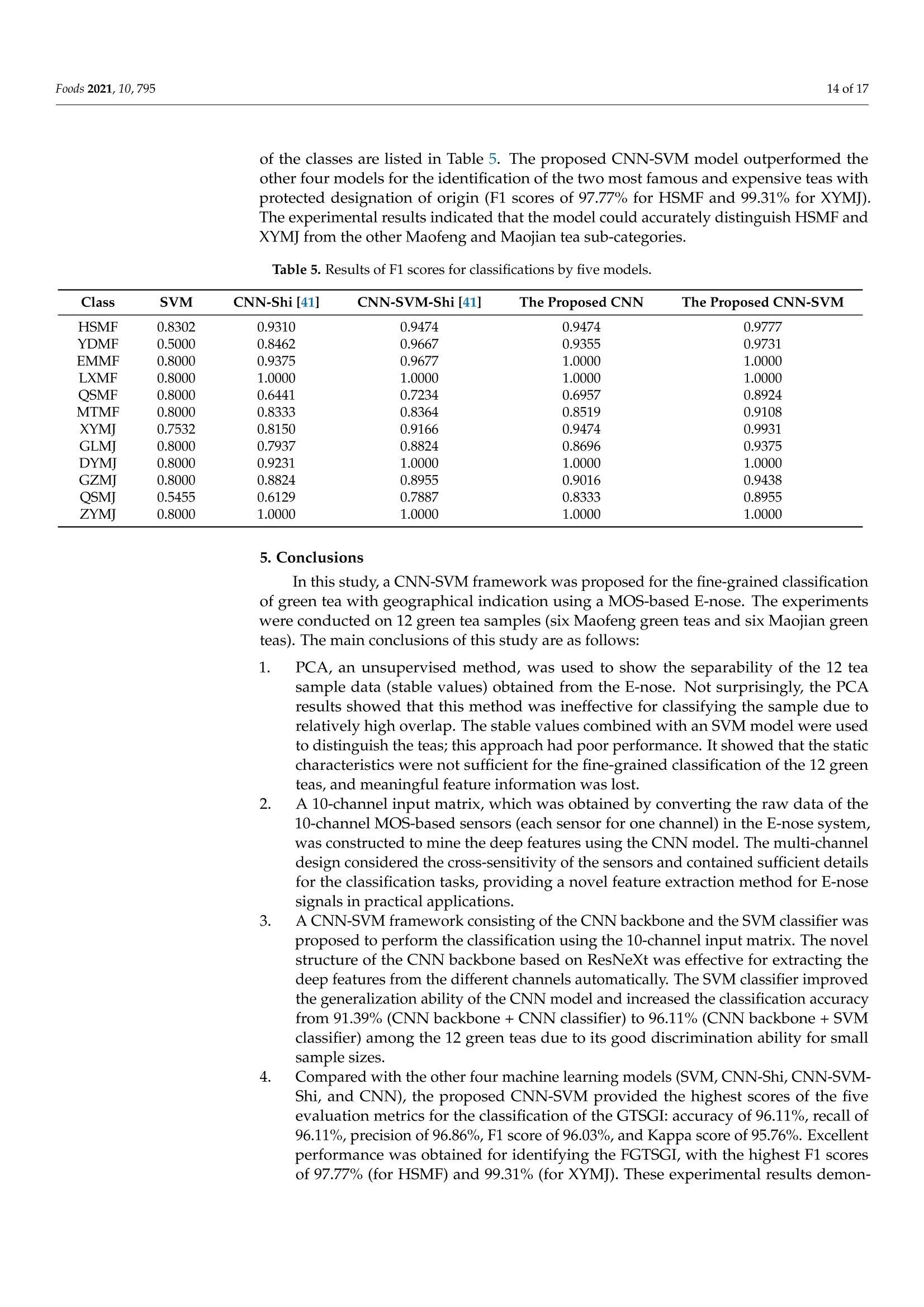
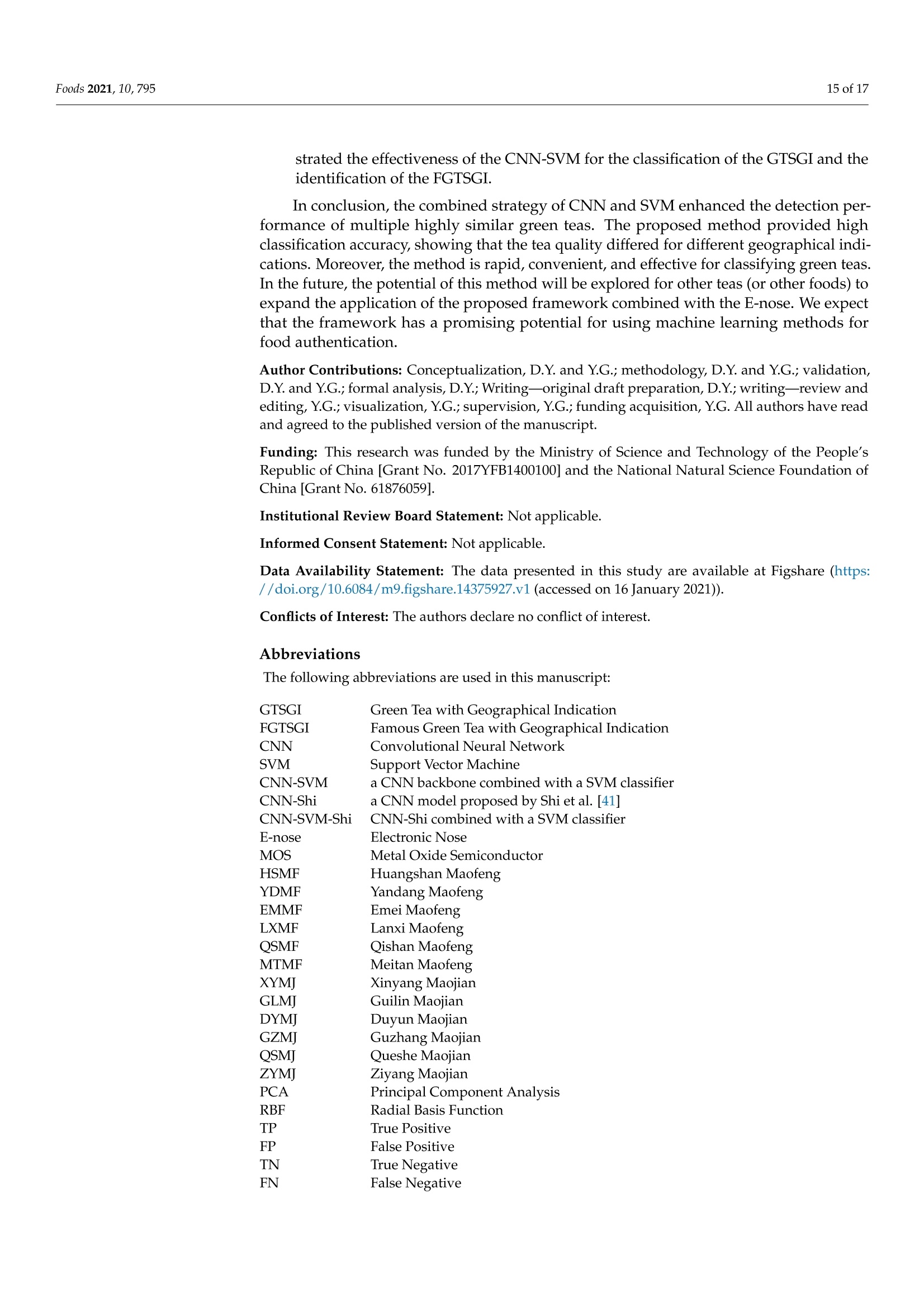
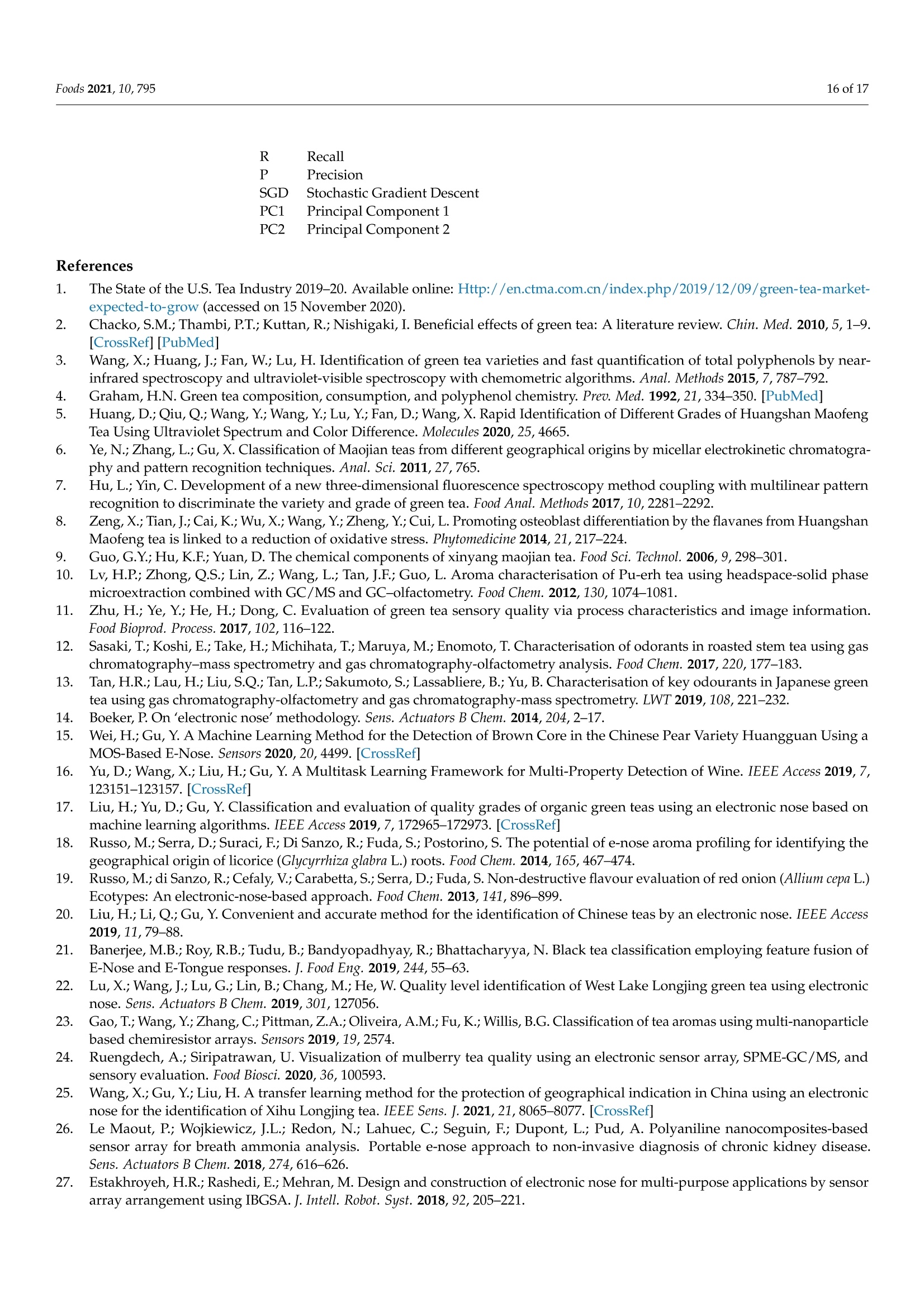
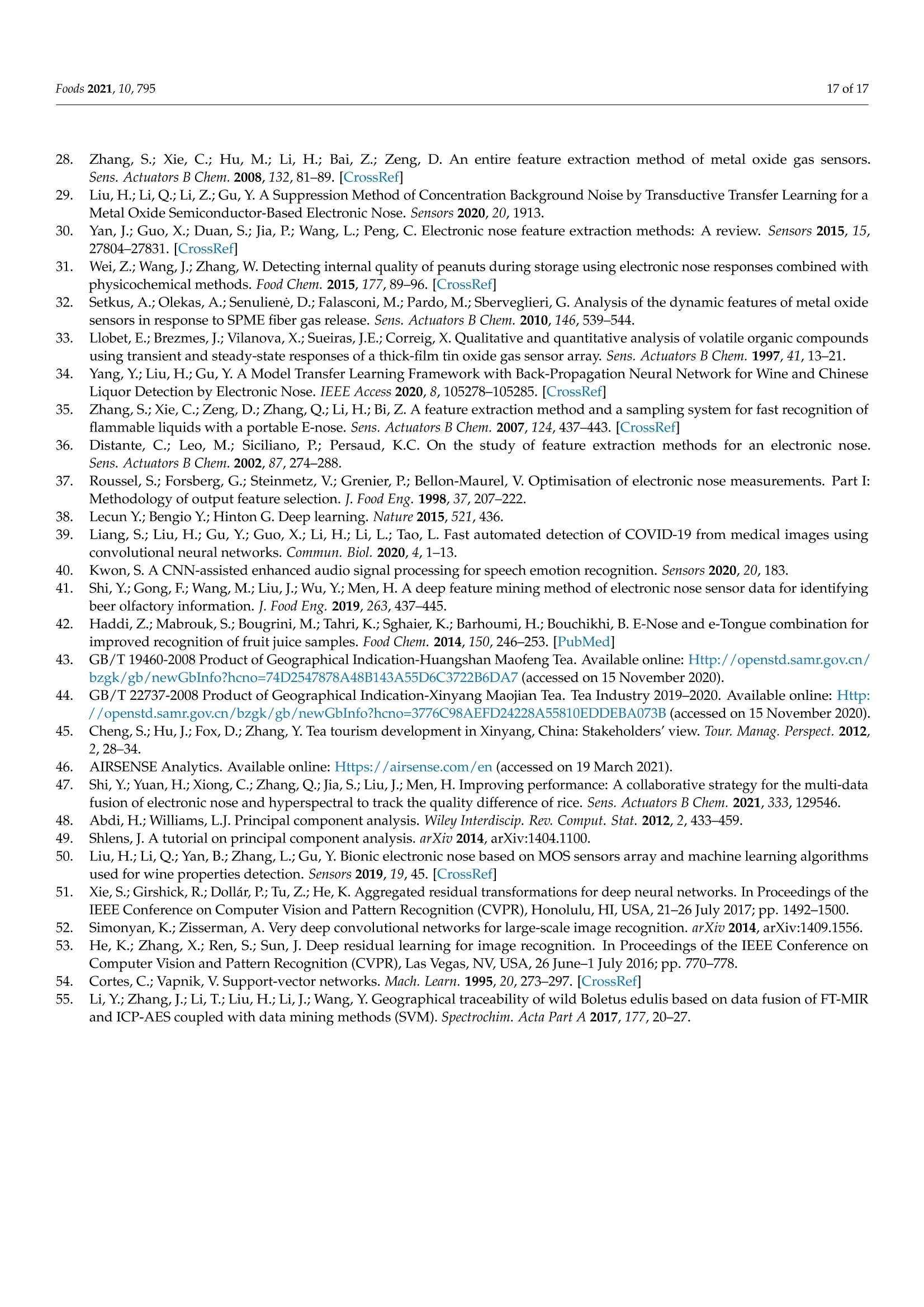

还剩16页未读,是否继续阅读?
北京盈盛恒泰科技有限责任公司为您提供《绿茶中风味特征检测方案(感官智能分析)》,该方案主要用于茶叶中理化分析检测,参考标准--,《绿茶中风味特征检测方案(感官智能分析)》用到的仪器有德国AIRSENSE品牌PEN3电子鼻
推荐专场
感官智能分析系统(电子鼻/电子舌)
相关方案
更多
该厂商其他方案
更多










